
This is a guide on How to make a starting layout and level up citizen’s homes in Nebuchadnezzar, all three citizen classes. I first show how to start food and goods production chains and set up required services for homes. I also explain the distribution of food and goods from the different markets and the transportation between warehouses using caravanners. Advanced tips for trade, making money, building monuments and more.
Start & Level Up Citizens Homes / Guide for Food and Goods Production Chains
This is a tutorial on How to make a starting layout and Level up citizen’s, peasant’s, homes in Nebuchadnezzar. I show how to start food and goods production chains (grain-bread and milk), ceramics and set up a water supply for homes.
I also explain the distribution of food and goods from the poor market and the transportation between warehouses using caravanners. Advanced tips for production and transportation efficiency included.
Now, let’s start from a nice empty map. First you need to locate an area with a good amount of fertile land where you can grow grain and set goats to graze so they produce milk. If the map doesn’t have large fertile patches you can easily create more by setting up a small irrigation system.
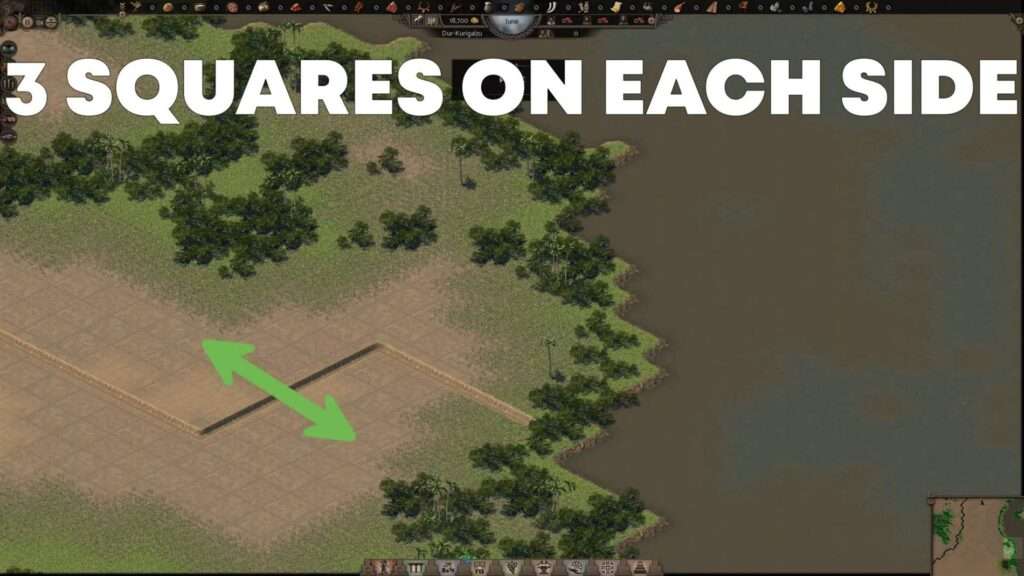
An irrigation channel will supply water to and make fertile 3 squares on each side of it. You fill it with water from a river by placing an irrigation pump between it and the riverside. If the channel is not fully filled you need an additional pump. Since these don’t require workers or maintenance feel free to add as many as you need.

Now that the entire channel is filled you can plan where to place your first farm. To feed peasants, your first citizen class, you need a grain farm and a goat farm. The green dotted line shows you the maximum range in which you can set up individual fields for that farm. Try to overlap them as little as possible, but some overlap will be alright.
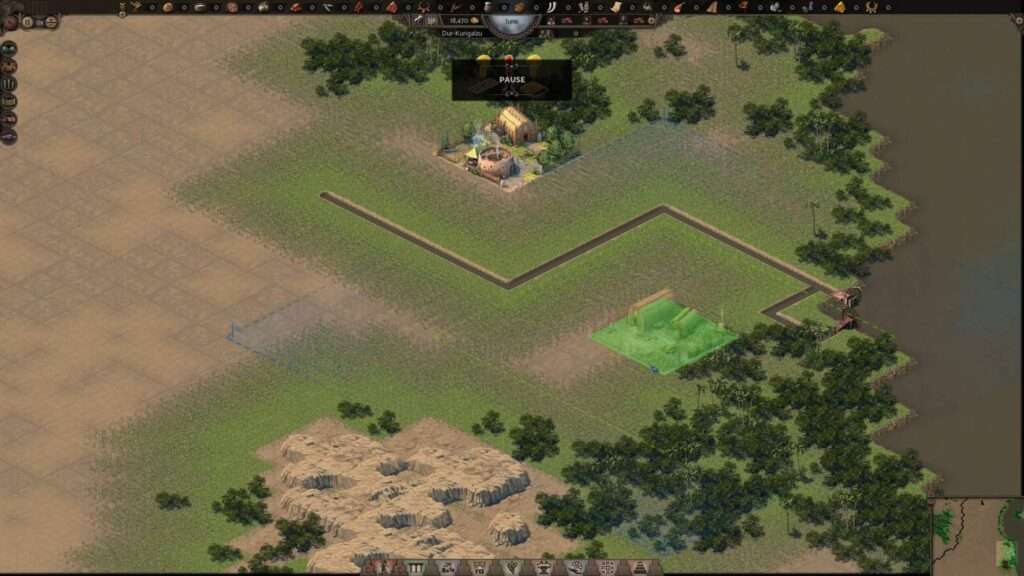
Now you need a warehouse which will receive grain and goat milk and which has to be in the range of the farms haulers, workers which transport goods. This is represented by the blue dotted line. Each farm needs a road to the warehouse but since the warehouse does not have a specific entrance any square around it will do for an entrance point.
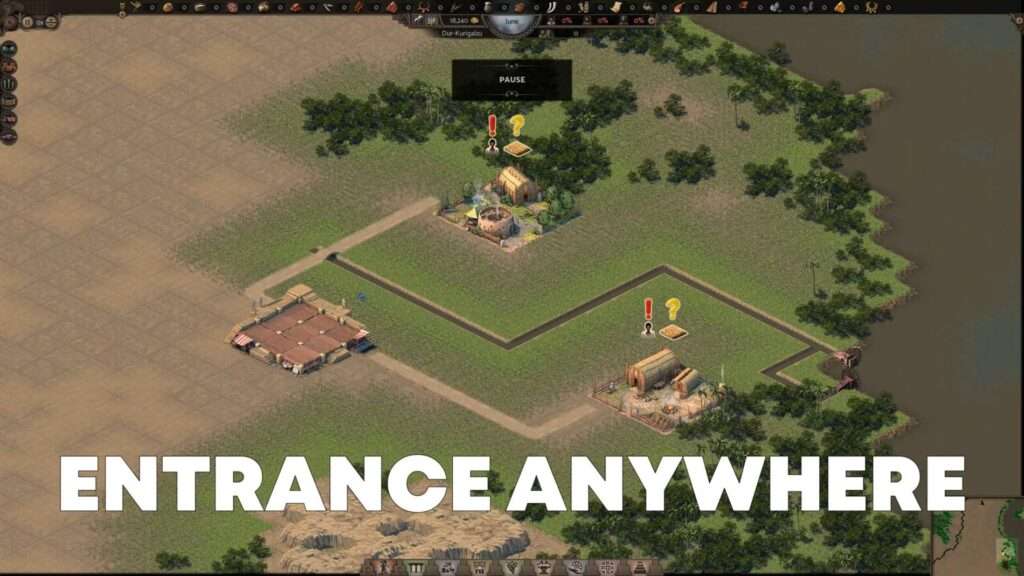
Since goat milk is produced constantly and grain seasonally, set up the limits so that you reserve more space for grain. Turn all other goods off for this warehouse. As for the farms there you will find two slots filled with farmers or shepherds and one hauler as well. Add one more shepherd for the goat farm and then choose the goat pasture option. Place the pastures until you fill each shepherd’s maximum workload. That is 18 each.
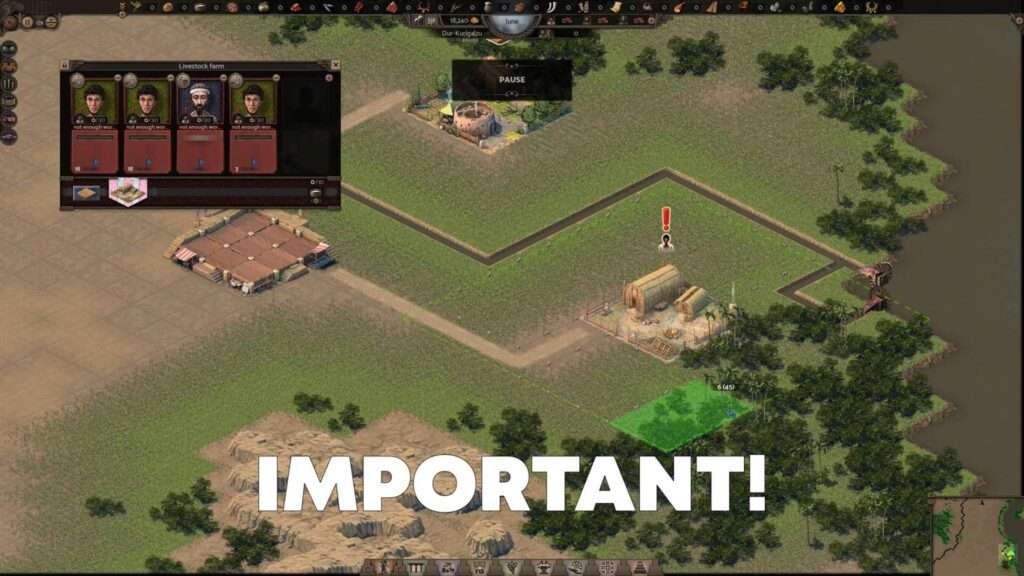
One advice here: When the road to the warehouse is this long, for three shepherds you will need two hauler. The longer the road the longer the round trip and it will create a bottleneck in production.
Now repeat the process for the grain farm. When adding the individual farms, plan for the placement of the future farms and place the farm plots accordingly.
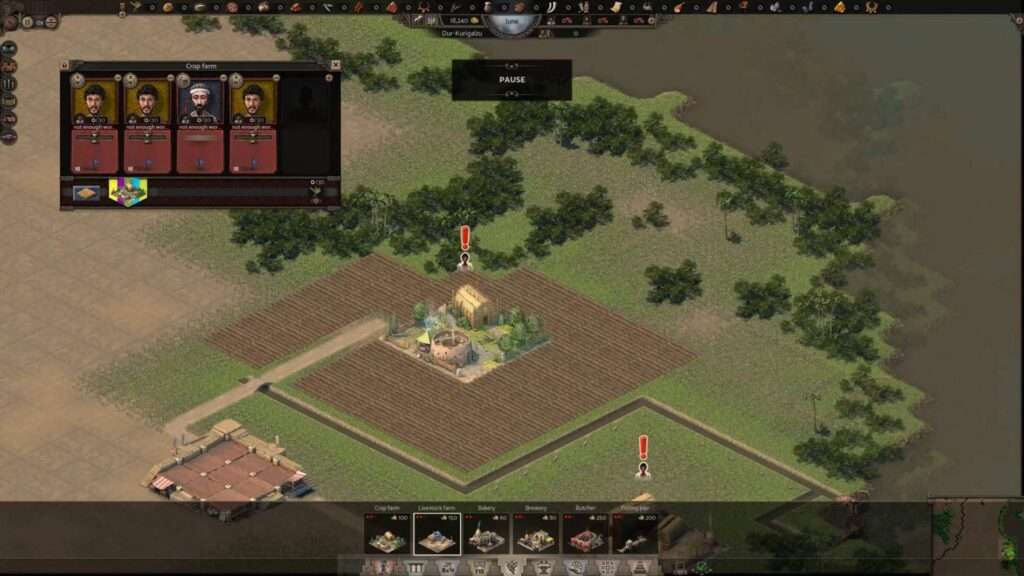
After this is done, we need to find a clear and wide area for placing the future homes of your new citizens. Them being the peasants, as only their class will settle in a new city where there is no food or water.
It’s important for this area to have places with no rocks, as you will need to incorporate wells in this layout for future upgrading of peasants’ homes.
A good rule of thumb is to place two wells on the opposite end of a single long road as these will be the core of your new settlement. The homes and other important buildings needed for growth will be placed in between these.
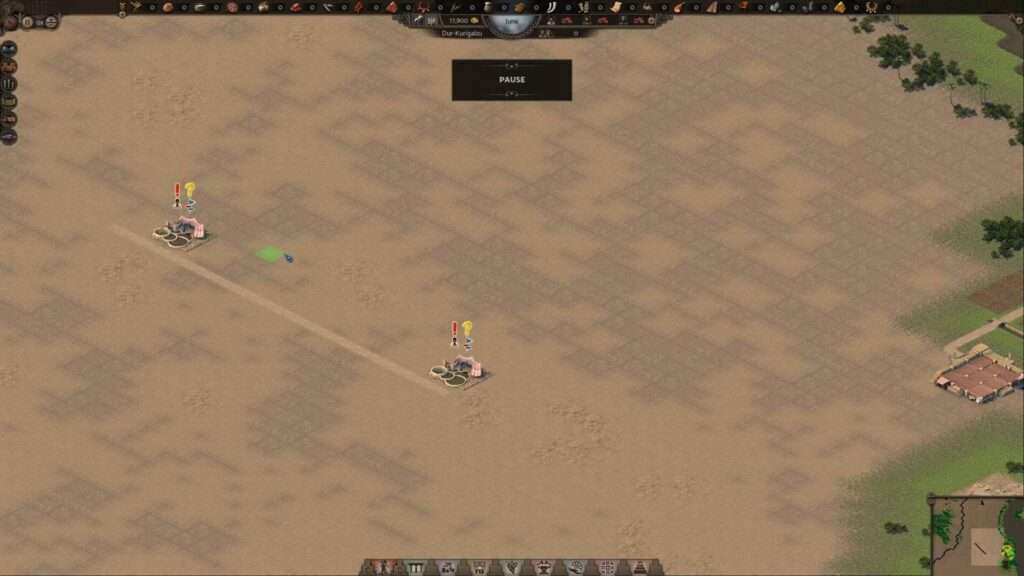
But before those you need to place new warehouses into which you will bring food and other goods these peasants will require of you to level up their homes. Four warehouses is ideal, and you will learn why shortly.
Poor market is the next building you need as it’s workers will distribute food and goods from these warehouses. You want them places really close to the warehouse as that cuts down on the travel time of haulers and makes them more efficient.
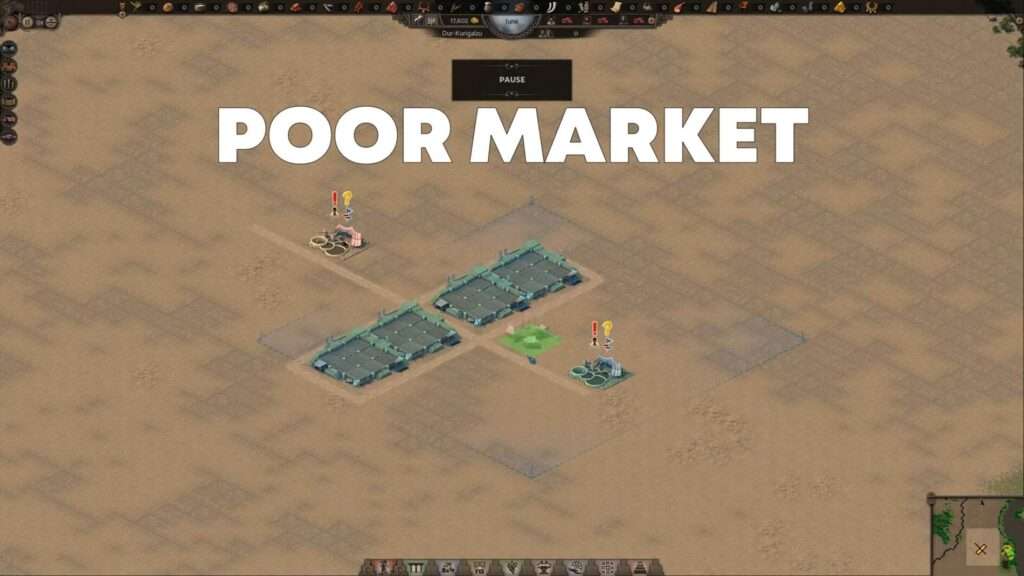
Besides water, food and goods, to level up peasants homes to their maximum fourth level you need administrators. This is why you can already add this building to the layout or just leave an empty 2 by 2 spot for it. For administration to function you will need another good in the future and that’s what the fourth warehouse is for.
Just like farms markets have two types of workers. Haulers to bring in goods and traders to distribute them. Each good requires its own trader and it’s own path. But to set that up we need to add more roads and fill the spaces in between them with peasants homes. For starters you can eyeball it but about three dozen homes will get you started.

It’s important to limit each warehouse to one particular good so you can organize it’s transportation from production to consumption centers. One for bread and one for milk. The other two we will use later.
Since we are going to be producing grain but peasants eat bread we need bakeries next to the warehouse where grain will be delivered. Two for starters, more later. Now to transport the bread and milk to the consumption center we need caravanners, workers from a specialized building which transfer large amounts of goods from one warehouse to another.
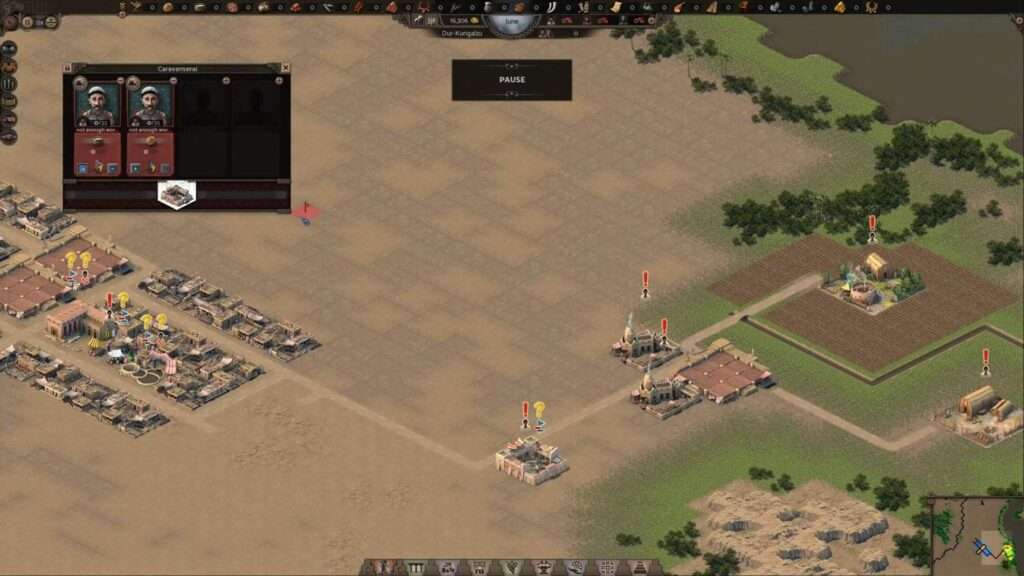
I would advise using a separate warehouse for bread as three goods in a single one can cause storage and delivery problems. The transport routes are set up by first selecting warehouses which will have goods and setting them for loading goods, and the other warehouse for unloading of the same goods. Red arrow is load, green is unload. Second, click on each caravaners pathing options, the plus sign, and set the start and endpoint for this path as warehouses with the same goods selected.
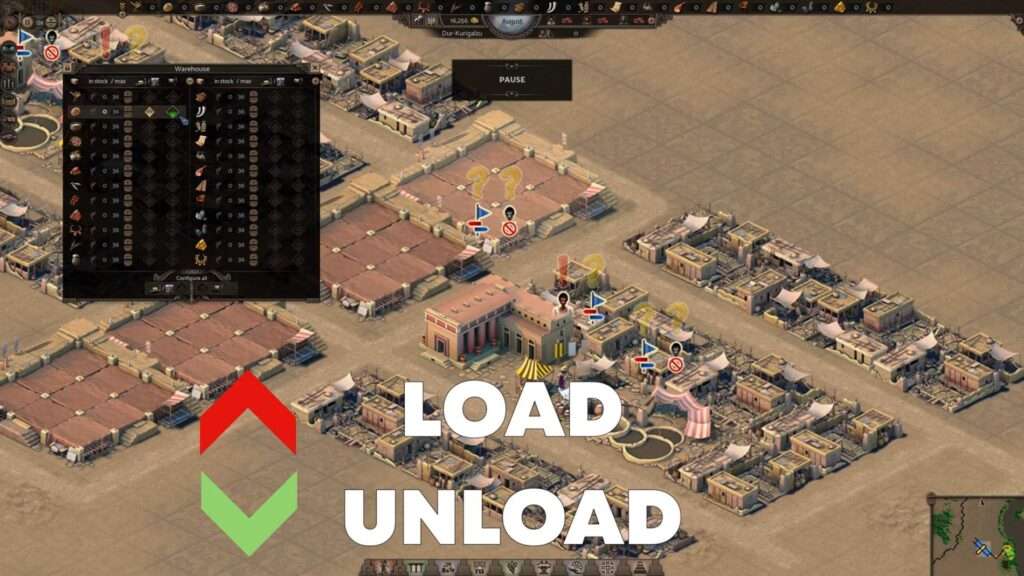
Now just connect your layouts roads to the main road and watch the settlers move in. They will pick up all the jobs currently available and production will start immediately. They don’t need bread and milk to move in, they need it to level up, so feel free to wait a bit for the warehouse to fill up before setting up the food distribution from the markets.
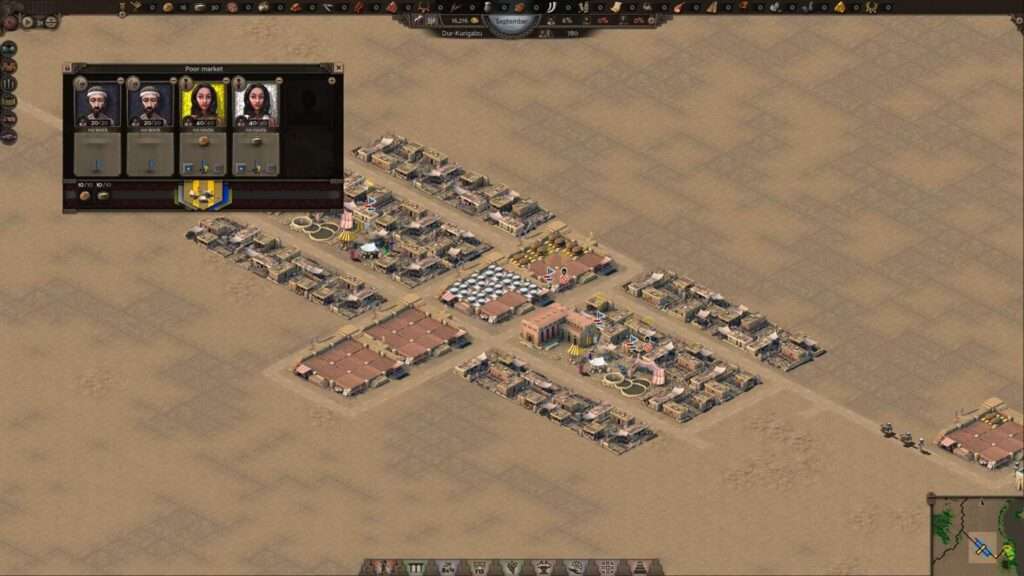
Distribution of Food and Goods
This step requires setting up the food distribution by adding paths for the market traders which have to go past each home in their path for that home to receive a delivery of the food or goods that each trader distributes. If the home turns green, it’s covered. You can easily copy that route to another trader by clicking on the green flag of the first trader when you start making a rout for the next one.

Because of that long road between the goat farm and the warehouse two haulers are needed to move all the milk.
The instant peasants receive milk and bread they will level up their homes and more of them will move in increasing your workforce. Now you can add another goat farm to boost production as well as another grain farm, but you don’t have to have them fully efficient as you won’t be spending that much bead and milk yet.

With homes and markets filled with food and peasants leveled up to level 2, it’s time to plan for the next level up. For it they will require ceramics and water. Wells for water we already have, so now we need a ceramics production chain. It starts with clay pits which can’t be built on rocks, naturally. Start with two, and then add ceramic workshops. You will need a warehouse to store finished ceramics so add that one close by and set it to receive only ceramics and to load them onto caravans.
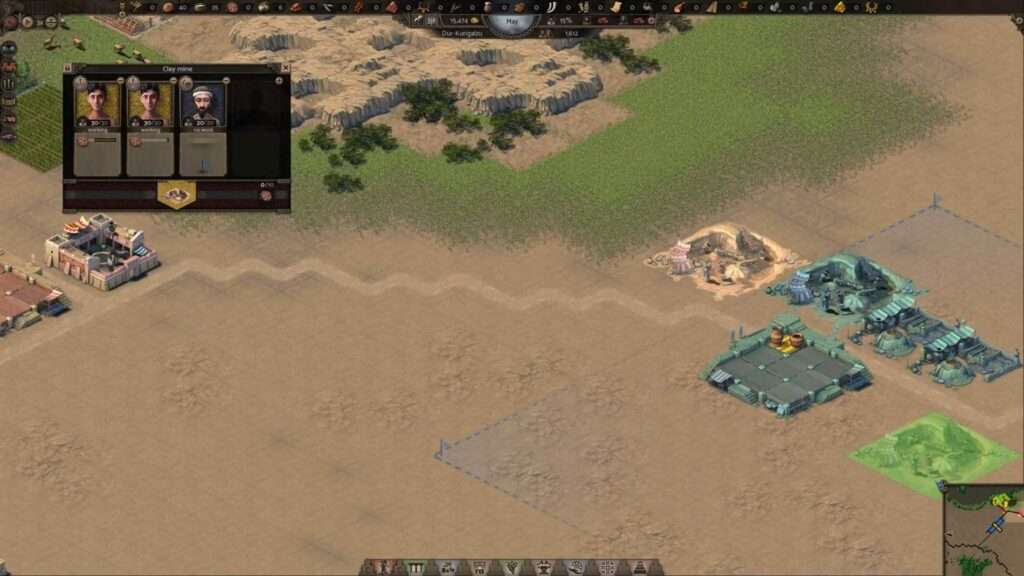
Similarly, set one warehouse in the center of the city to offload ceramics from caravenass. Add a new caravanner and set his route to load ceramics at the production site and unload at that warehouse. While you wait for ceramics to be produced add more clay pits and ceramic workshops to have more supply.

If you need more workers or have warehouses overflowing with food, add some new peasants homes, extend the roads to cover them and add more stops for the traders from the market to deliver food to these homes as well.
With ceramics warehouse full, add one more trader to each market to deliver ceramics and copy the same path from other traders. Turn on the wells and add delivery paths for water onto the roads covering all the homes.
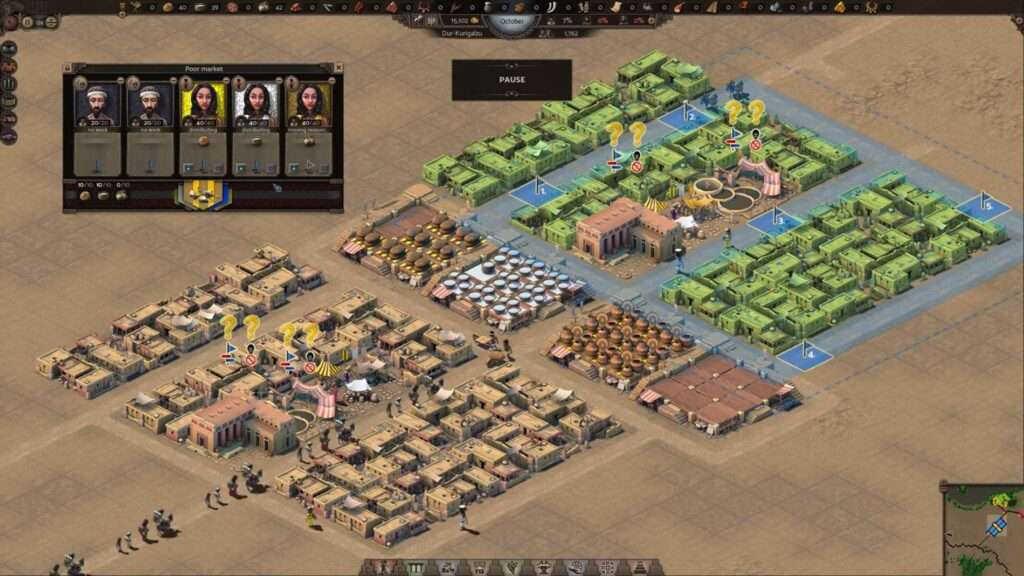
If necessary add more production of ceramics once homes start to level up to level 3 to have a constant supply. You can use the overlays, keyboard keys 2,3 and 5 to check the goods distribution.
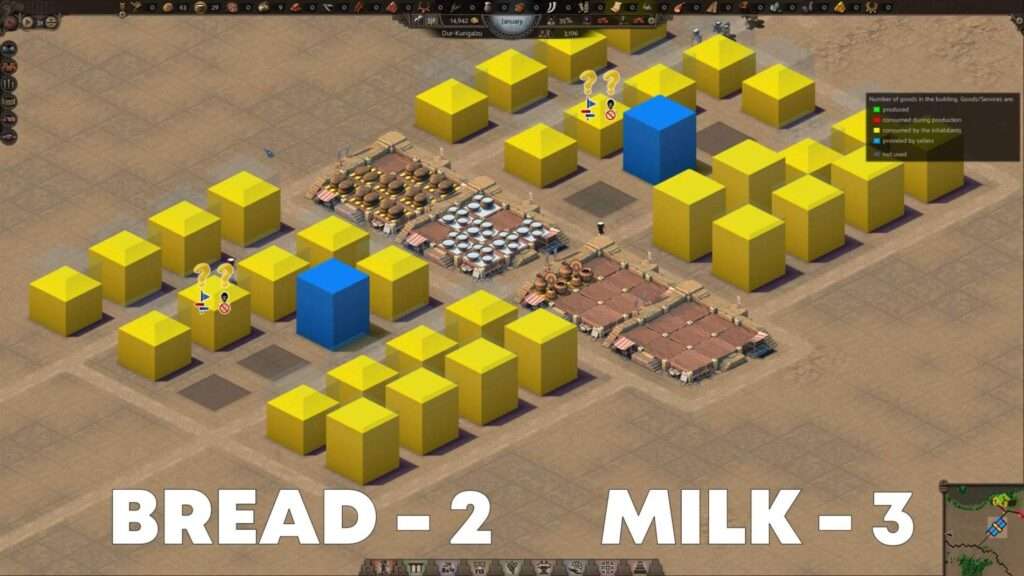
As for leveing up these homes to level 4 they require beer as a new good and administration from the buildings I mentioned in the beginning of this guide.
But since peasants can’t be administrators, you need the second class, townsfolk. They won’t be moving into your city before you meet their requirements but that is a whole other subject and I will cover later in this guide.

Setup Villas for Townsfolk / Guide for Monument, Import, Export & Gold
This is a tutorial on How to setup Villas for Townsfolk in Nebuchadnezzar. I show how to start food and goods production chains (dates and fish), add appeal with beatifications and religious service while preparing production of copper jewelry.
I also explain the temple monument construction, how to set up and unlock trade routes, with prestige, for import and export of goods, through ports, so you can earn gold (money). I guide you through preparation for leveling peasants homes to their maximum level with administration and production of tablets and beer. Advanced tips for efficient goods distribution from poor and standard markets included.
I showed you that townsfolk require dates and fish to move into the city, and that without townsfolk working in administration buildings which also require tablets to function, peasants won’t be able to level up their homes to the maximum level.
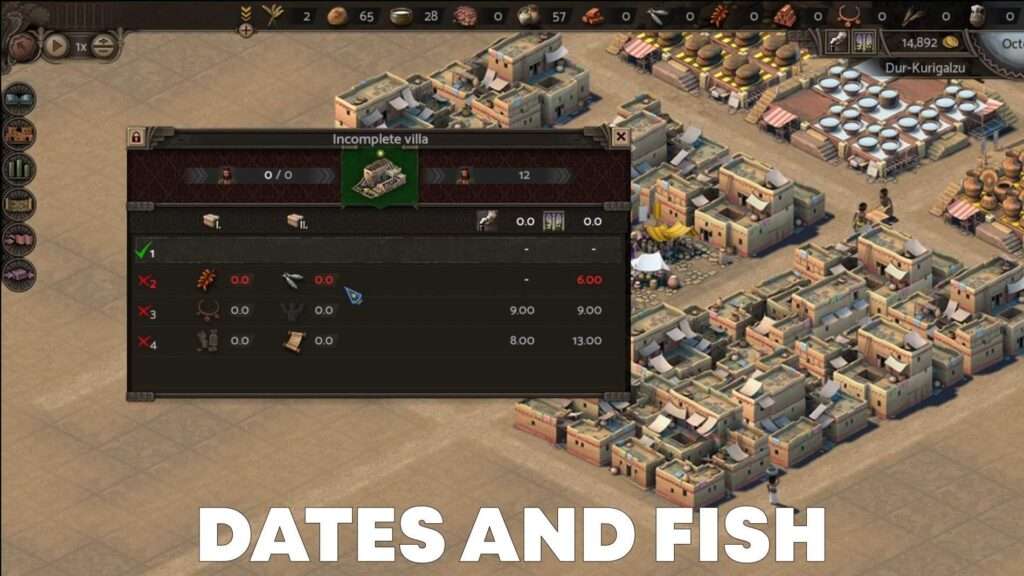
The second requirement is beer which is produced in breweries where townsfolk work. To make tablets which the administration buildings use we would need a tablet workshop in which townsfolk are also the workforce.
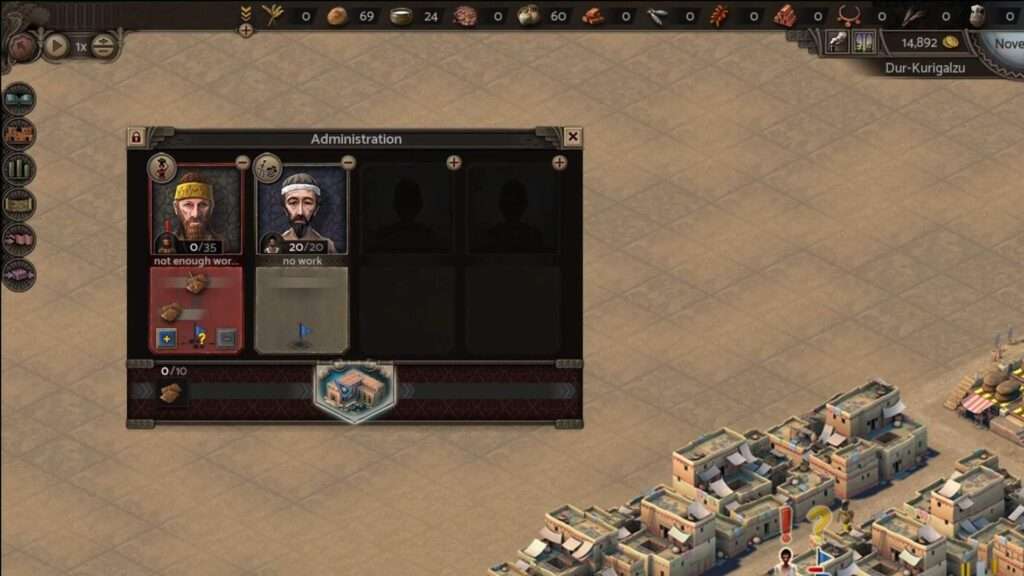
So we need quite a few townsfolk in the city going forward. That means that besides the first level of villas and the new townsfolk coming in we will need them to level up to their second level to have more townsfolk workers. The requirements for this are copper jewelry and access to religious services.
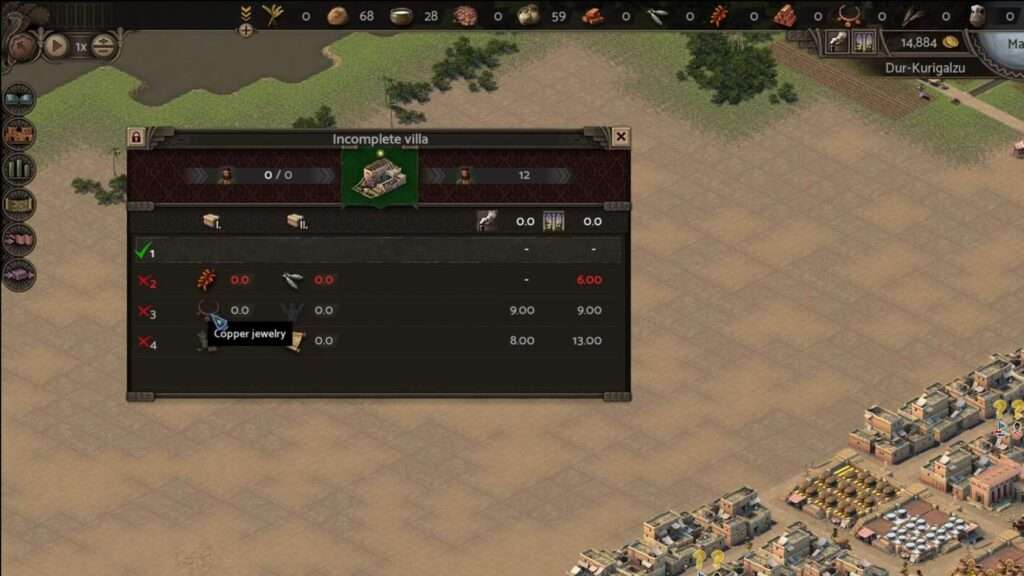
Since we can’t mine copper ore we need to trade for it. In the trade and diplomacy window we can filter other cities by import and see that only Magan has copper ore for exporting and it imports beer. To be able to trade with this city we need 70 prestige, but currently we only have 33 prestige in this city.
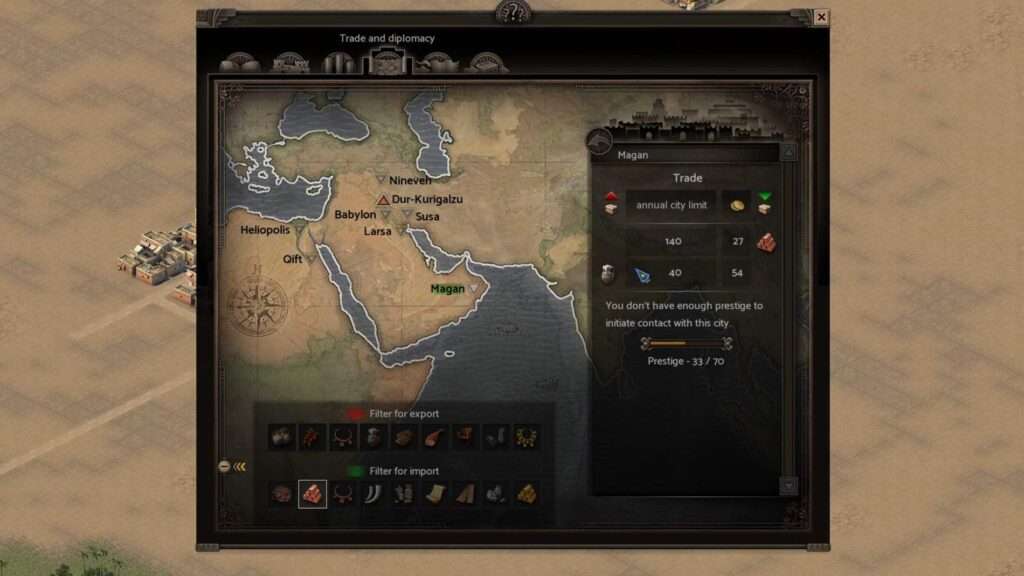
If we take a look at the prestige windows we can see that constructing a temple would gain us 140 additional prestige. Since we do have 35% unemployed peasants and temples are made from clay bricks, which peasants make, we can add a bunch of brick makers and some extra clay pits to start the temple construction.
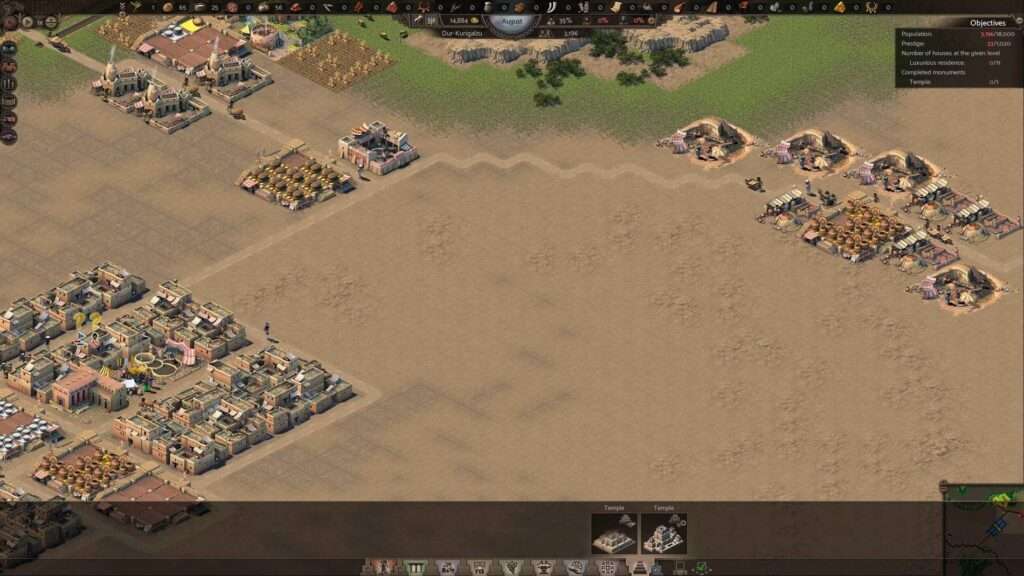
I am going to go with the automated temple construction because I want to use the time while the temple is being constructed to build more of the city. The workshop which receives bricks should be placed near the clay pits so it’s in the range of the future brick maker’s haulers. We will place 3 now and add more if necessary to speed up the construction.
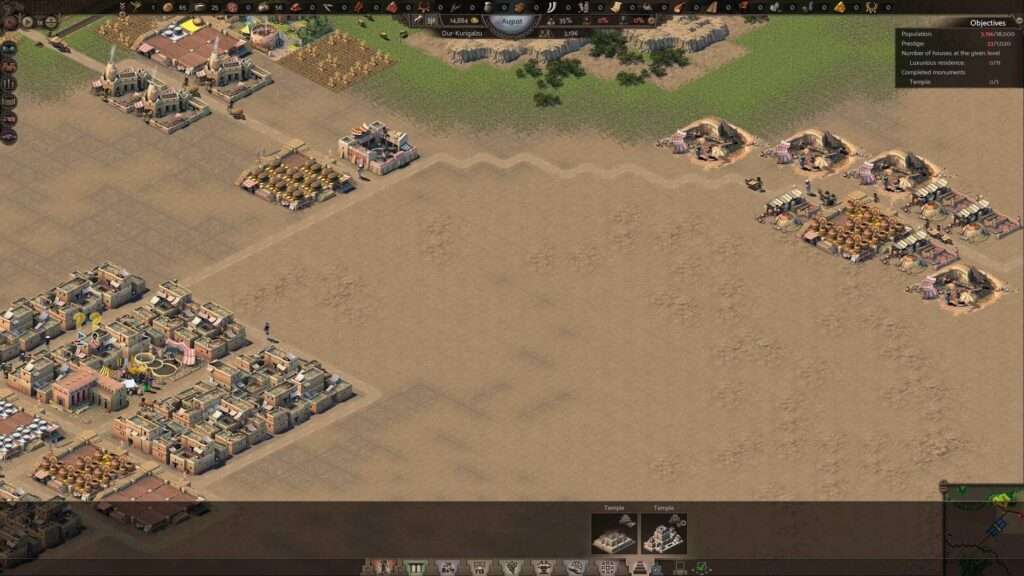
Because we have more than ample supply of ceramics we will turn off one workshop for that good and have the clay pits supply the brick makers. Add some extra clay pits and we are done.
Now we can concentrate on making goods which are required for townsfolk to even move into the city. Dates and fish. We have on this map a river and some lakes. But even if we were to find a spot big enough to place a fishery that wouldn’t help because the fish only live in the river.
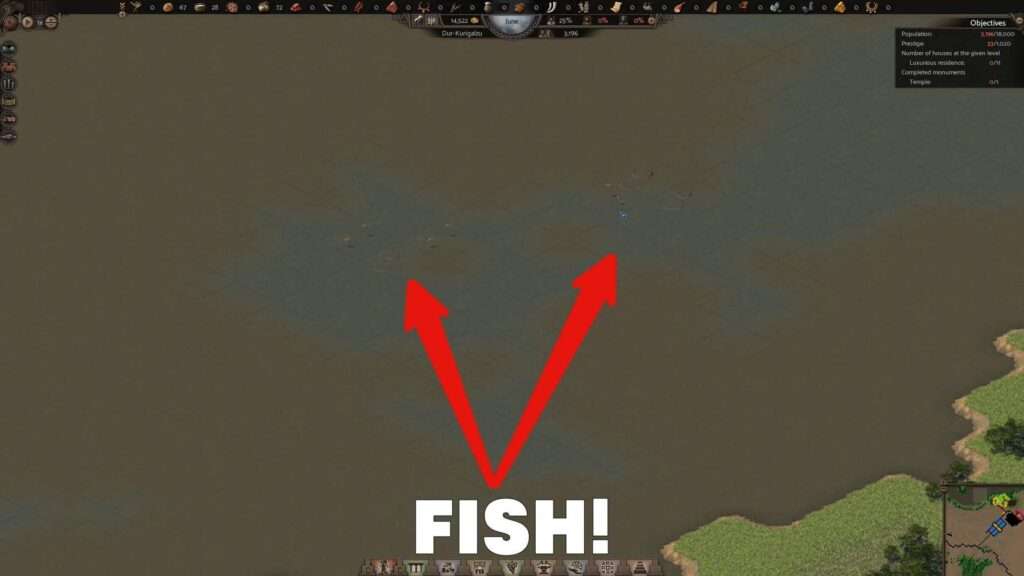
So this is where we want to set up the fisheries. But this requires a bit more planning that you might think because ports also take up space on the riverside and they require specific placement because of their size.
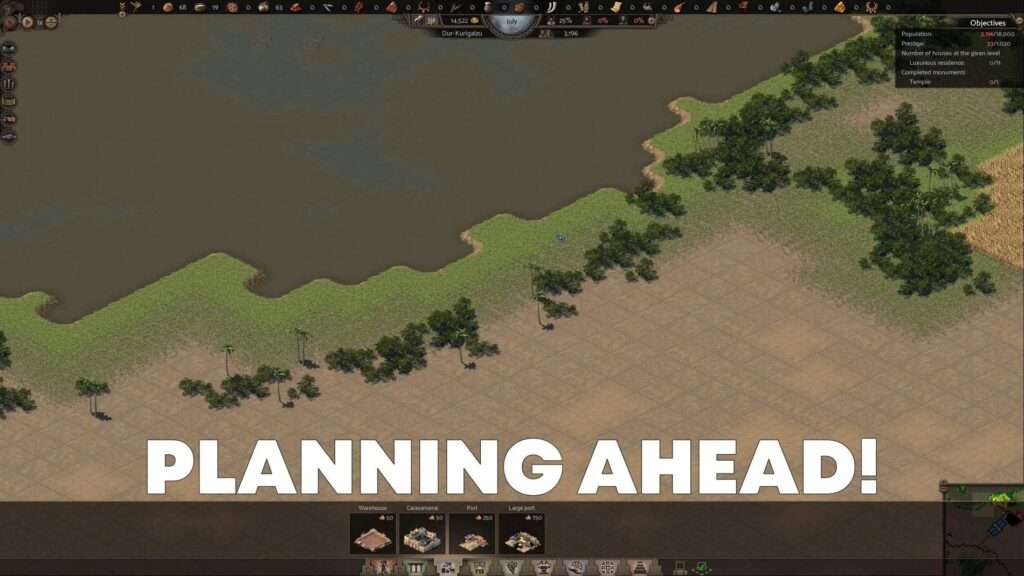
A port can’t fit where there aren’t 4 plots in a straight line. So we want to save up these spots and not set up a fishing industry here. We are going to place one port and in the future we can even set up a big port on this spot, because it’s the only spot which can support its size.
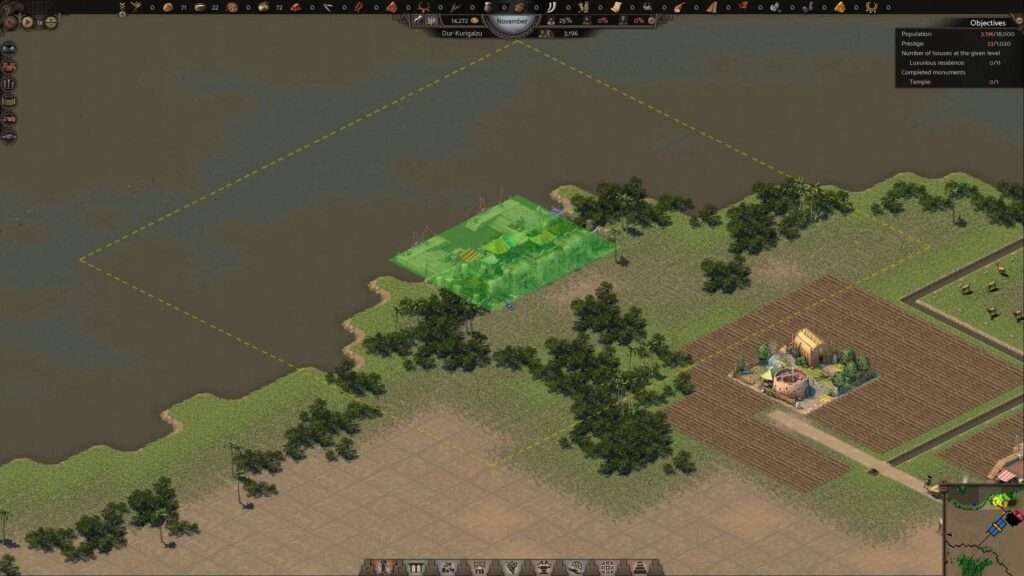
Using the blue flag icon on a port we can see the range inside which the port can exchange goods with warehouses. So we want to avoid building anything else inside this area. The first fishery can go to a near by spot and after laying down the road to connect it to the city it will start operating.
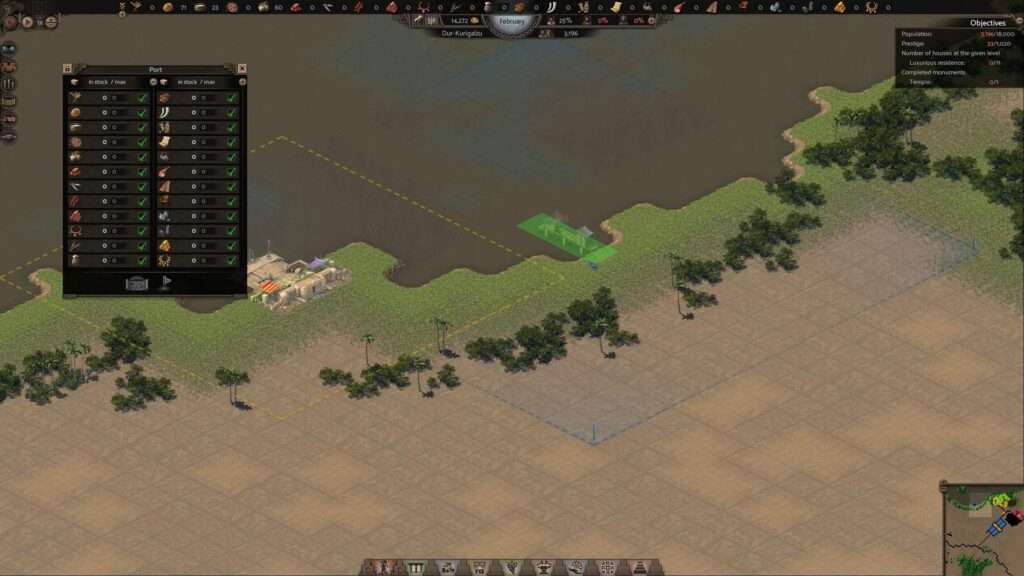
Adding one more fisherman will max out it’s production rate. All we need now is a place to store the fish, disable all other goods and set the option to load for the future caravan route. Speaking of which we need some extra roads and that caravaners building with one fish caravan.
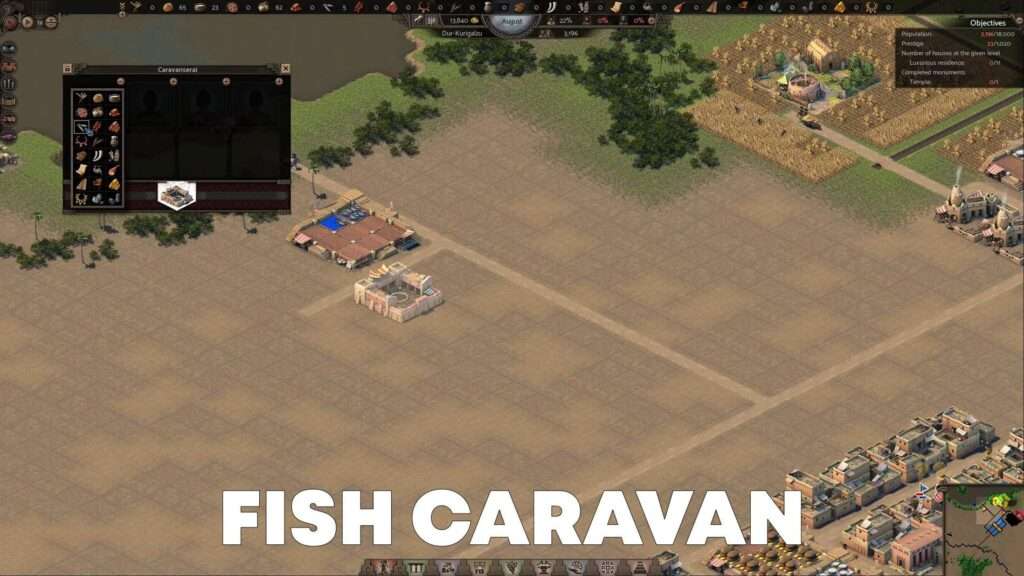
Food and Goods for Townsfolk
With this done we will let fish pile up and come back after setting up dates production. This is something that can be done down here near the lakes, but to make some more farmland available we will do the same thing we did in the first part of the guide and set up pumps and irrigation channels.
Since dates are produced on farms we need one such building here, a road for deliveries to go out and workers to come in as well as a warehouse for storing dates. There is always a trade off when placing the warehouse because the longer the road the longer the delivery time and less efficient the farm is.
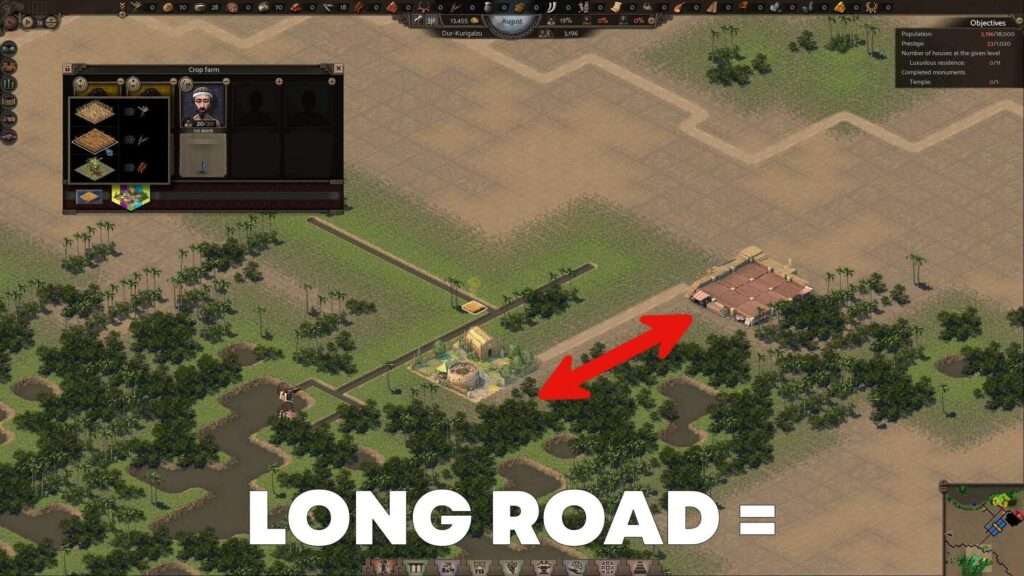
But the closer it is the more fertile land do you waste. Now we sow the dates and see how many workers we will need. Three full ones 18 farm lots each and fourth one with just two which we will disable. Connect the warehouse to the city and construct another caravaners building with a caravan for dates and we are done.
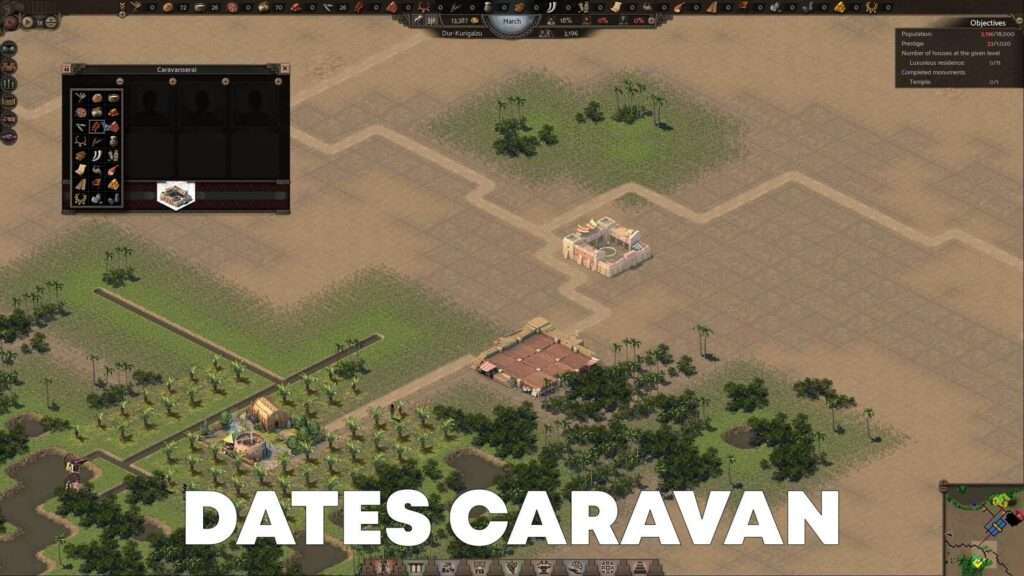
The temple construction is progressing steadily so while we wait for it to complete we should create a new area for the townsfolk to live in.
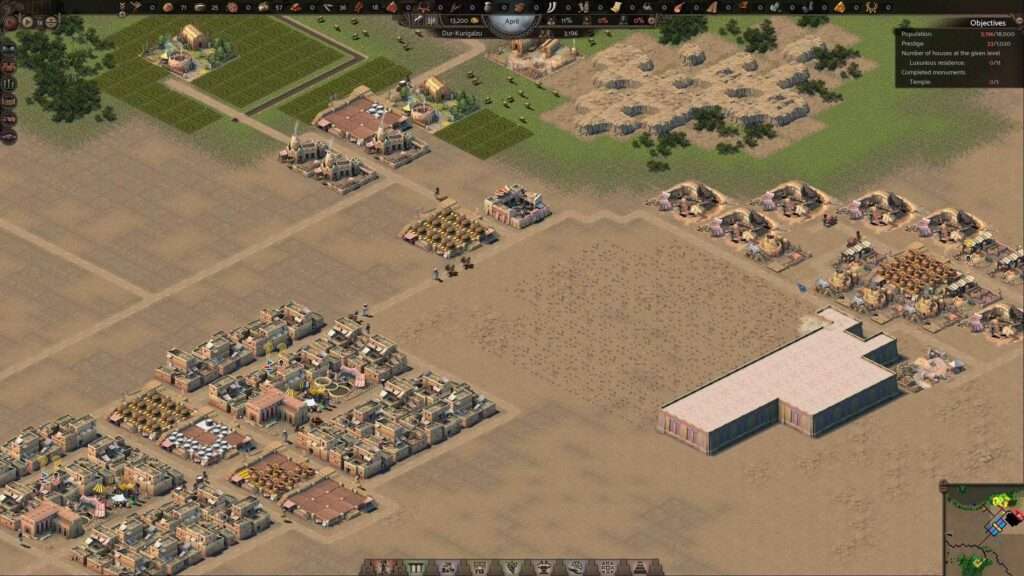
Since they only like places which have high appeal and no pollution we will set up far far away from industries and place decorative roads instead of the usual dirt ones.
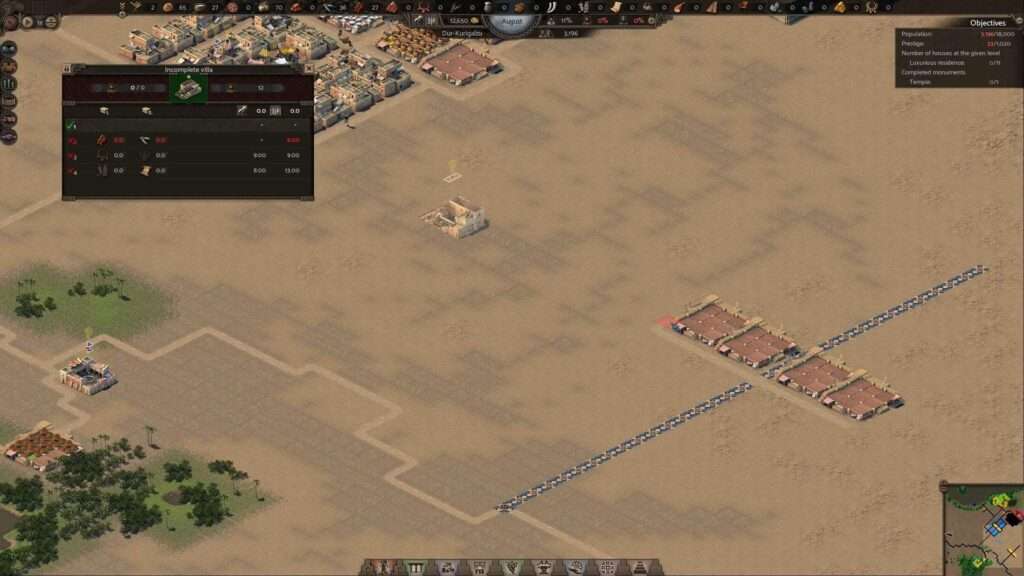
Of course food and goods need to be stored here so several warehouses will again go into the middle like in the peasants area. These can be surrounded by cheap roads. The townsfolk naturally don’t need a poor market but the standard market which distributes fish, dates, copper jewelry and another good which we will get to in time.
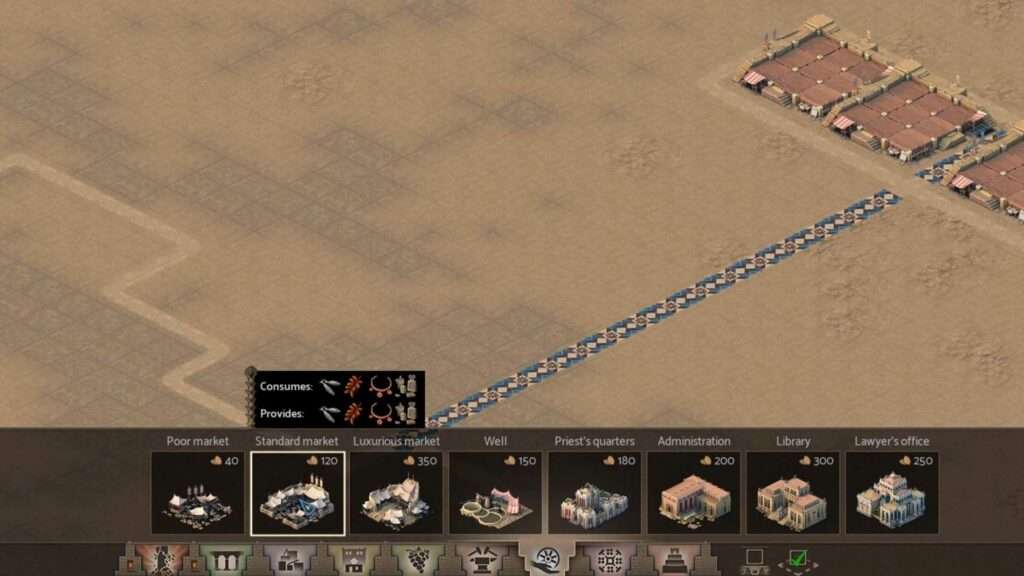
Again we are going with two markets, but this time right across the road from the warehouses. This is the maximum efficiency setup which means you only need one hauler as his travel time is at the minimum. I will showcase this a bit later on in the guide.
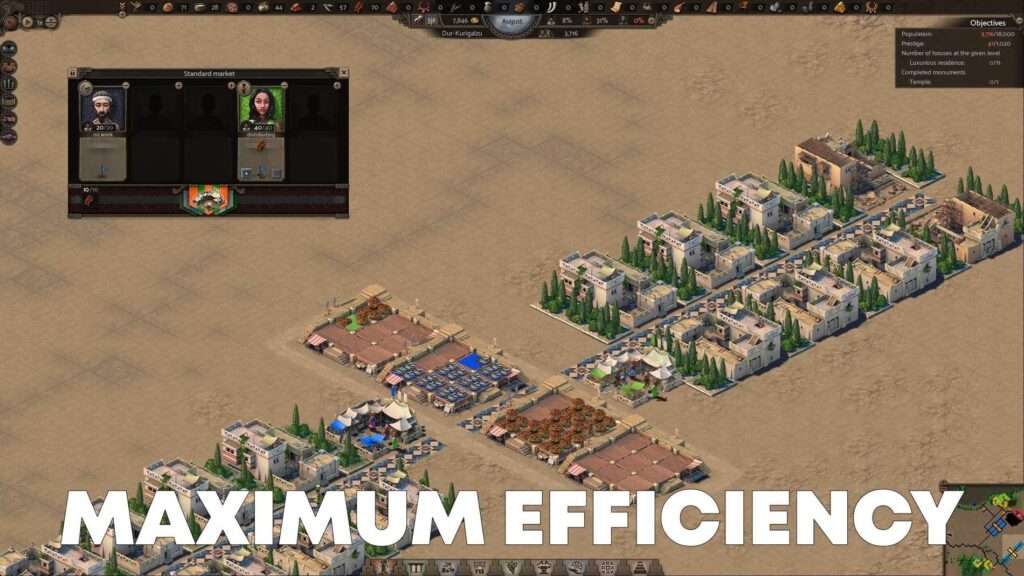
One market will distribute the dates and the other will supply the fish. The warehouses have to be limited to one good each so that caravaners from across the city can unload these goods in large quantities each run. Unloading being the green, down, arrow.
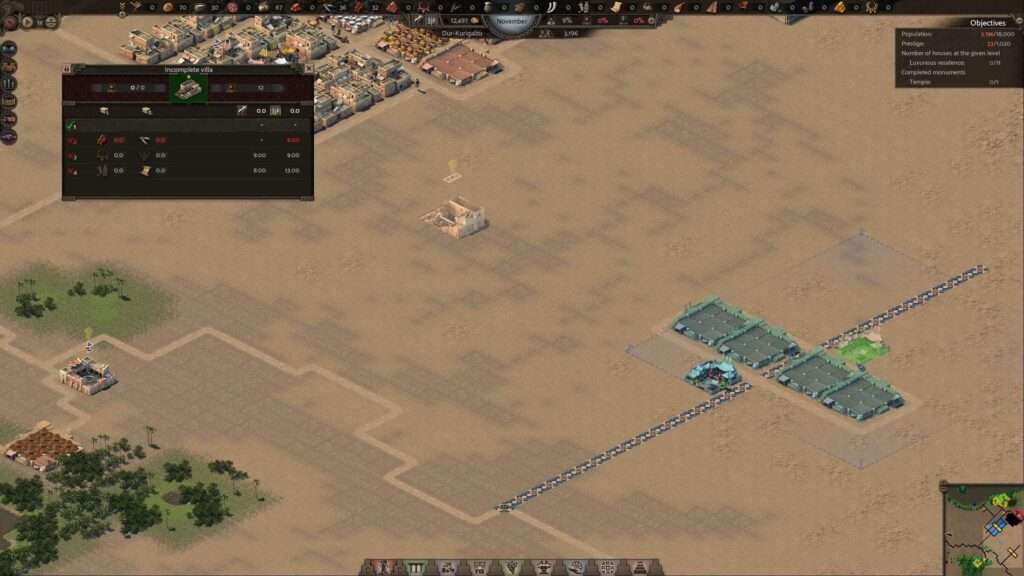
Now when we go back to the dates warehouse, which is full by this point, we set the path for the caravanner to bring the goods to these new warehouse. Same with the fish up on the river side. In case you forget to set the good, like dates, for loading, like I did here, the handy icon above the caravaners building will indicate that for you.
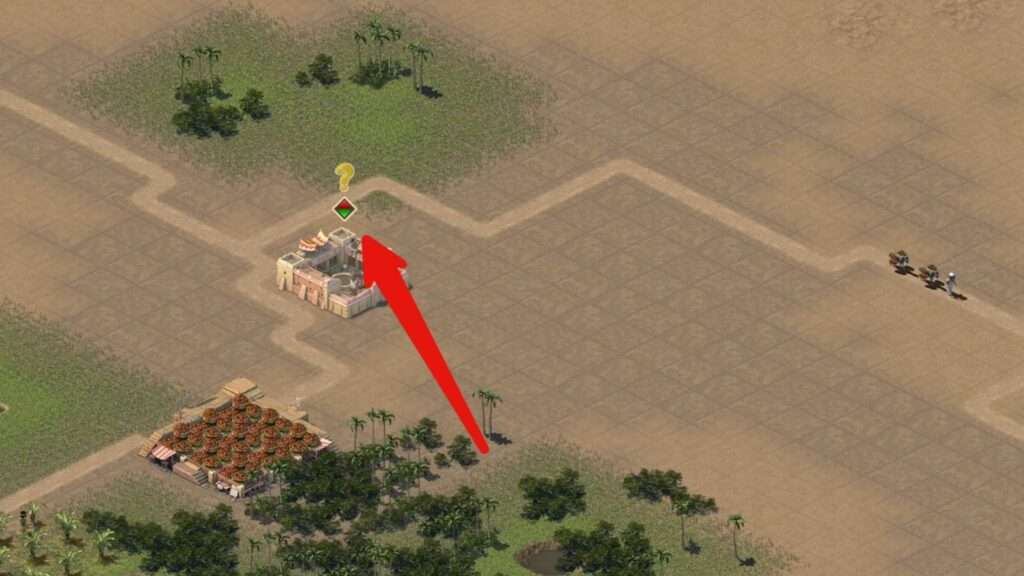
We can see here that this caravan carrying fish has already set out and delivery will come in shortly. We will let these warehouses fill up for now. If we take a look up here we can see only 6% unemployed peasants. We will soon need more workforce so lets find a way to get them.
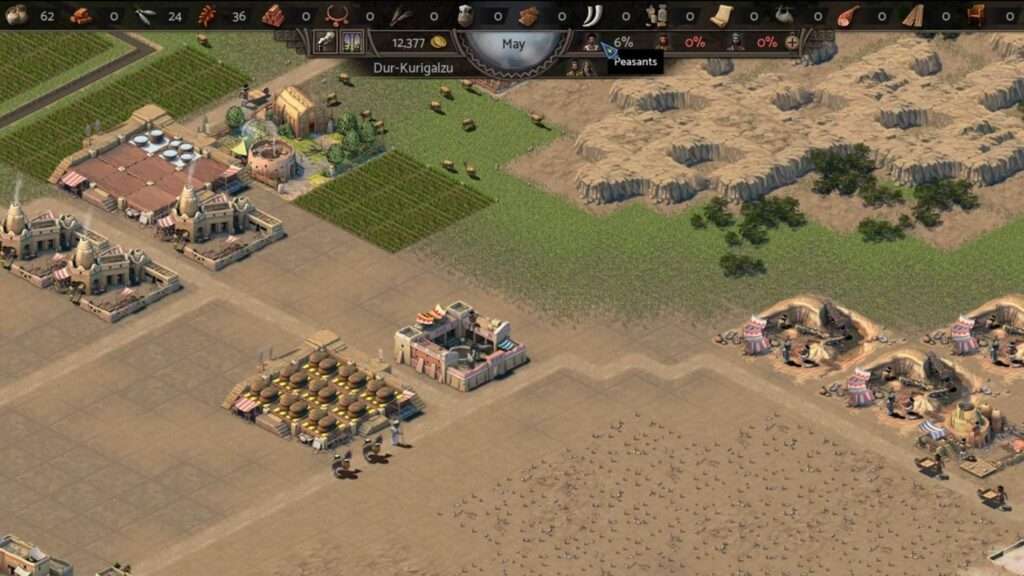
Looking through the warehouse, markers and peasants’ homes we can notice that they are totally satisfied with goods up to this level but we don’t have the goods or services to max them out yet since we don’t have tablets or administrators.
So we should just add new homes. We first check to see where the routes of the market distributors are and add new homes on those routes. Not too many until we know we have enough goods for them all. Now it’s also a good time to do some future proofing. We will add two new poor markets right next to the warehouse turning them off for now.
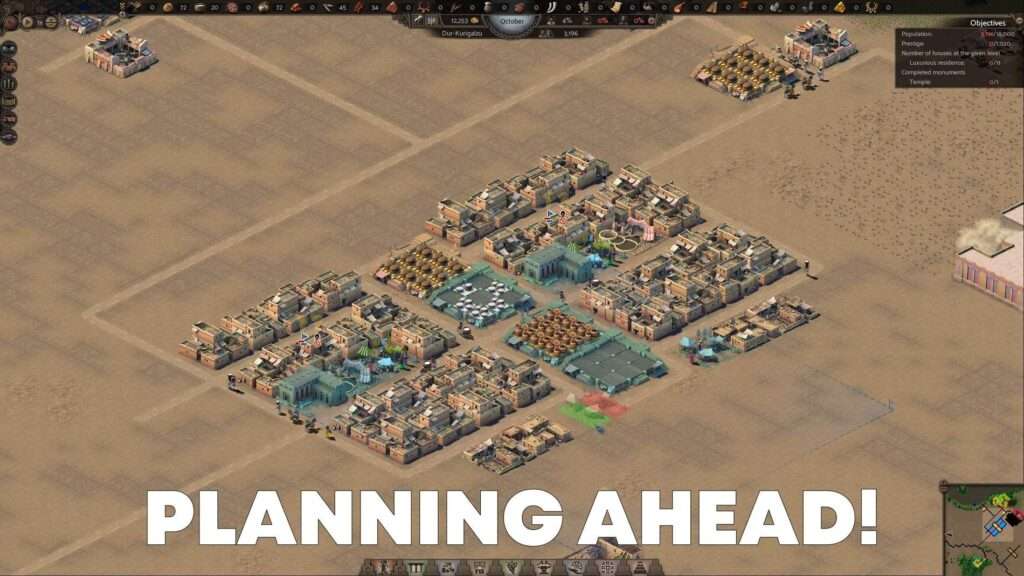
Looking back to the monument it looks like one of our brickmakers is too far from the monument’s workshop so to fix this problem a warehouse can be added, set to only accept bricks.
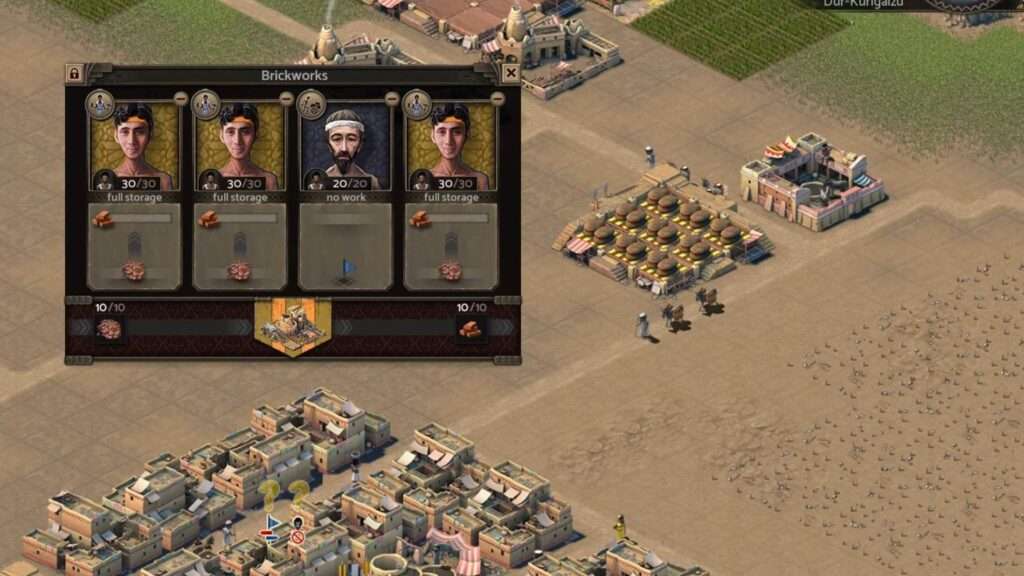
Then we add a new caravan for bricks and set them to be loaded onto it. The caravnast starting point is this warehouse and the end point the monuments workshop. In this way you can build a monument anywhere and just bring in the bricks.
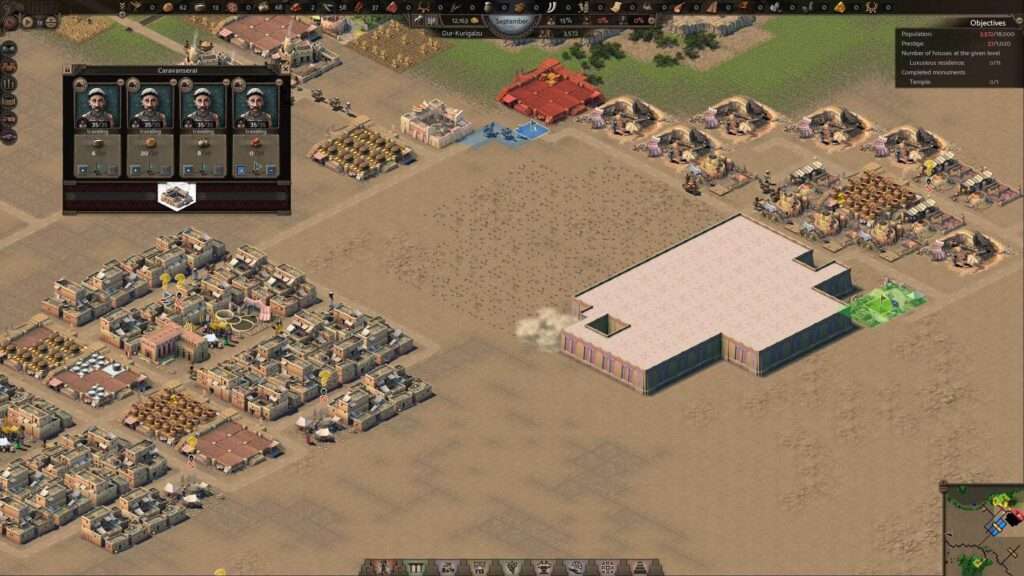
Here we have an interesting development. One of the homes has exhausted its supply of goods and has devolved, dropped down a level in other words.

It’s back to being a shack because it doesn’t have enough bread but this is quickly corrected by the distributors from the poor market. Looking at the overviews for bread, milk, and ceramics, we can see that there aren’t very high stockpiles of these goods in some homes, so we better check the poor markets to see what is wrong.
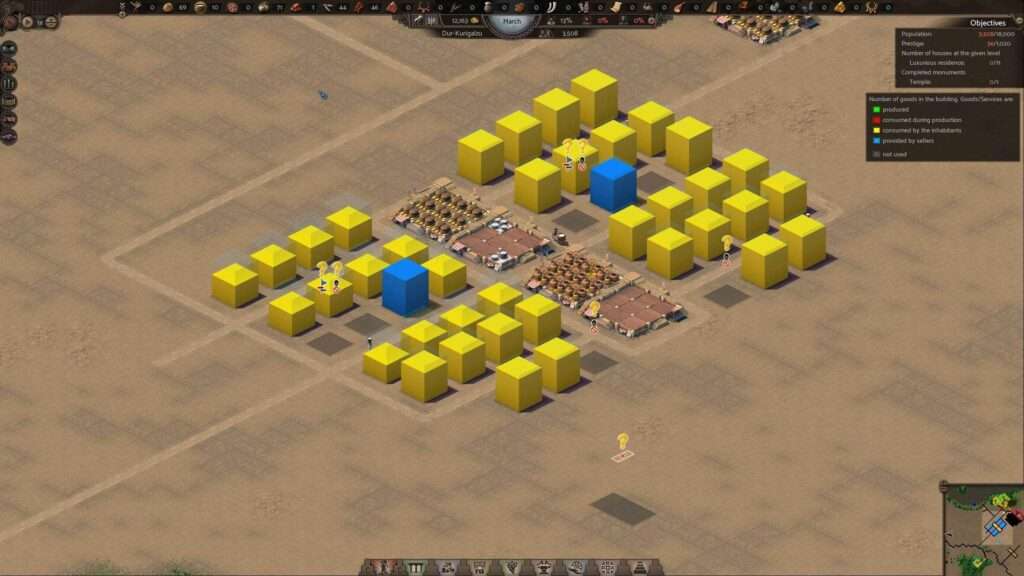
And there’s the problem. There aren’t enough goods in the market, specifically bread. But the warehouses show plenty of goods. So what’s up you might ask. Well I will show you.
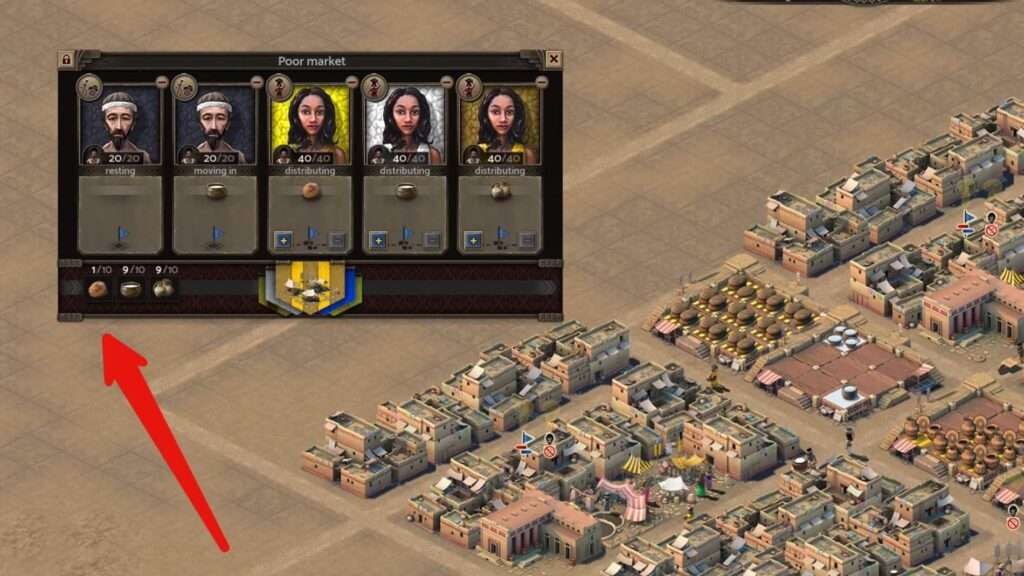
The problem is the low efficiency of haulers who have to move 3 different goods from three different warehouses to these markets and that is taking them more time then it takes the distributors to spend those goods.
So, it’s time for a redesign. Markets have to be moved right up against the warehouse as I did with the standard markets for the townsfolk’s villas. After some cutting and pasting of homes and markets, which resets those buildings, we can redesign the distributing network.
A market across the street from a warehouse full of goods that the market distributes now only requires one hauler and can use the rest of the slots for that one good type. Three new distributors require three new paths.
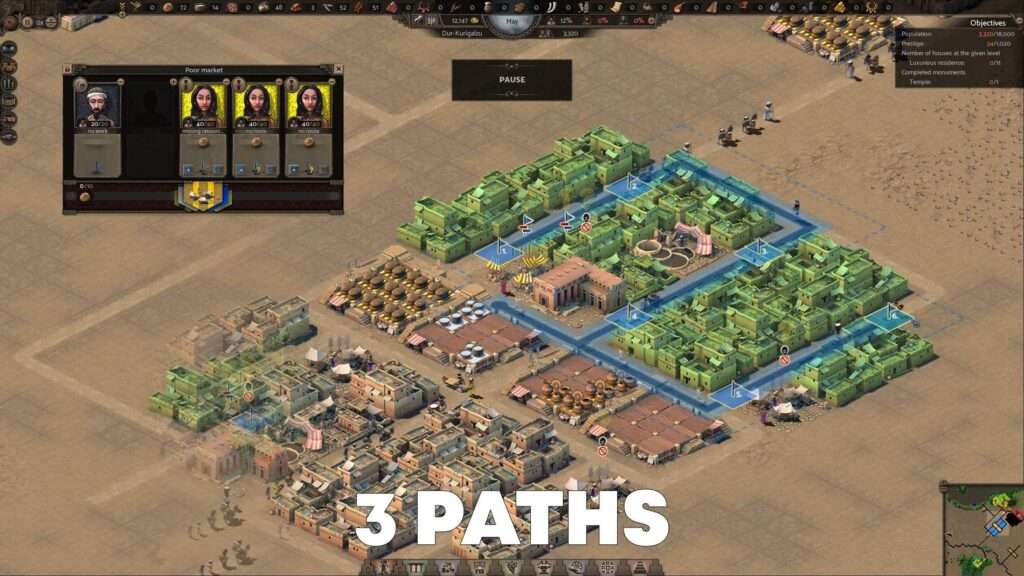
One for this part of the area. Second for the other side of the area and a third which covers the entire peasant’s area. Same is done for the market which will distribute milk. One hauler, three distributors, three paths.
And after that the poor market which will distribute the ceramics gets the same treatment. So now if we zoom in and take a look, we can see the haulers almost instantly transporting goods from the warehouse to the markets. This is as efficient as it gets.
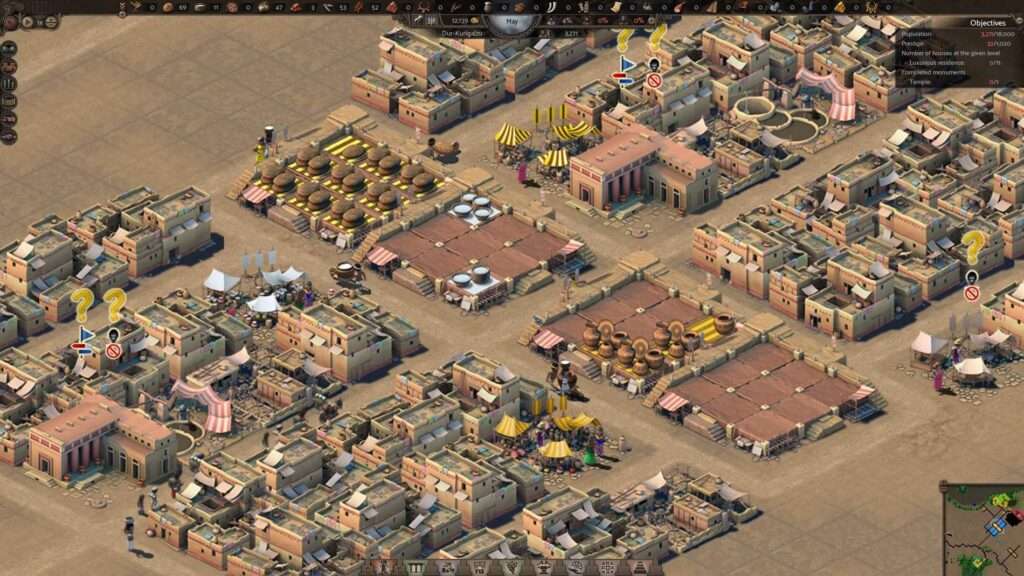
If we once again take a look at the overlays the situation is clearly better and all homes will be supplied constantly. It’s finally time to bring in those townsfolk into the city. And for that we need to place down a lot of villas.
The warehouses are full of food and more is continuously coming in. These villas as I mentioned earlier don’t like pollution but want high appeal from their surroundings. The decorative road will not be enough so we will leave some space between each villa for the placement of beatifications which raises appeal.
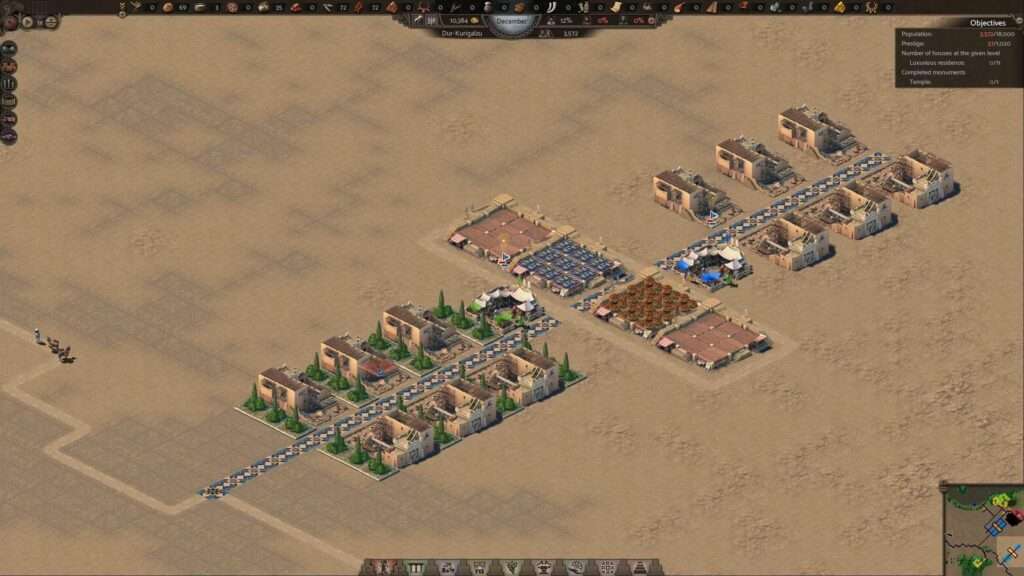
You can use this overplay to see the range of the current appeal.
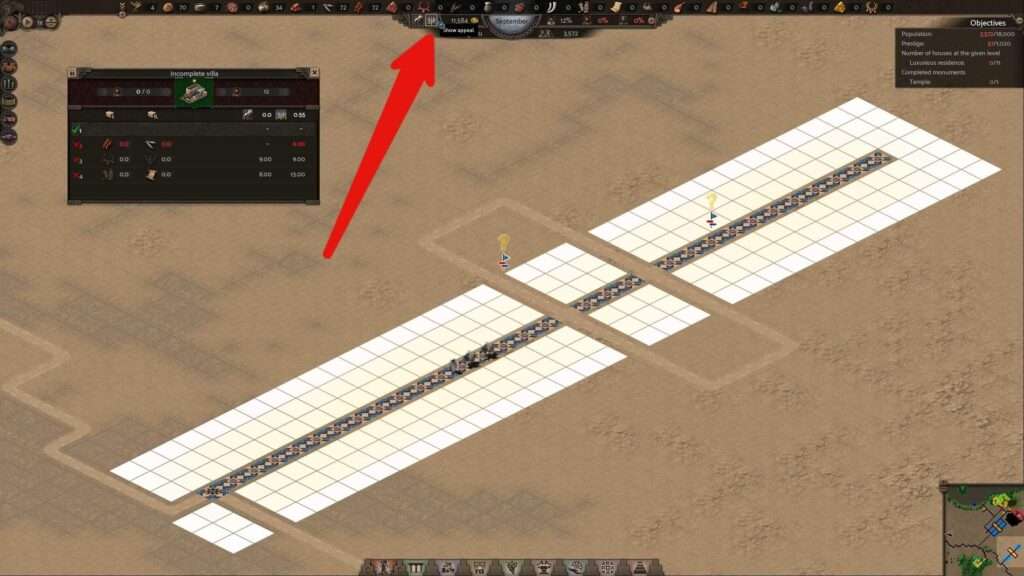
The requirement for townsfolk to move in is 6 so this is our target. As to not spend too much gold we can use just the simple gardens. This proves more than adequate to move up past 6 appeal. All that is left is to distribute the food. Dates and fish to the villas and they are ready for townsfolk to move in. You can clearly see the villas transforming as they have new owners.
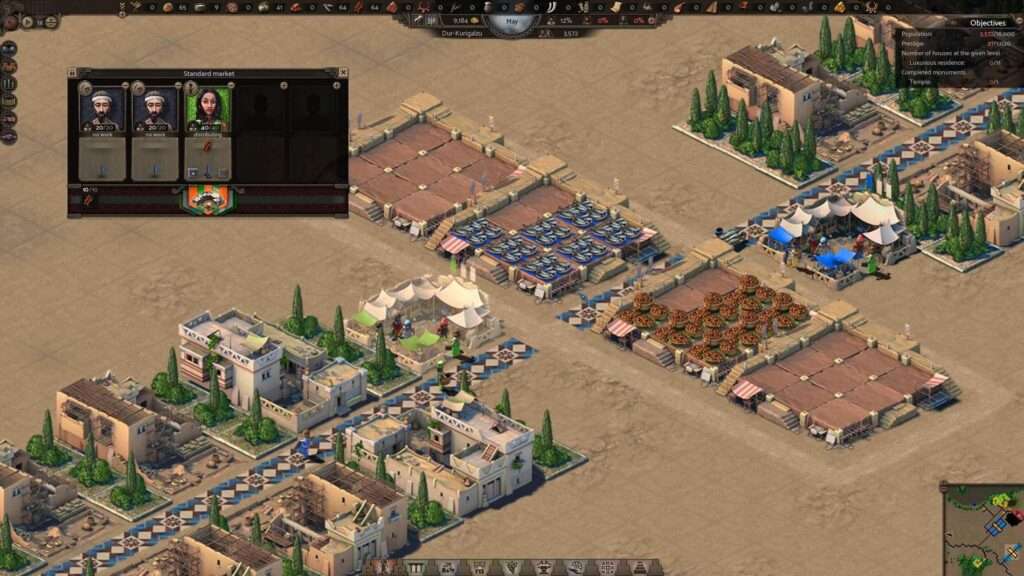
Preparing Peasants for Max House Level
Now here once again we have the same situation with the markets and warehouses as we had in the peasant’s area. So the solution is also the same. Distributors of fish in a market next to a warehouse full of fish. Same for the market distributing dates.
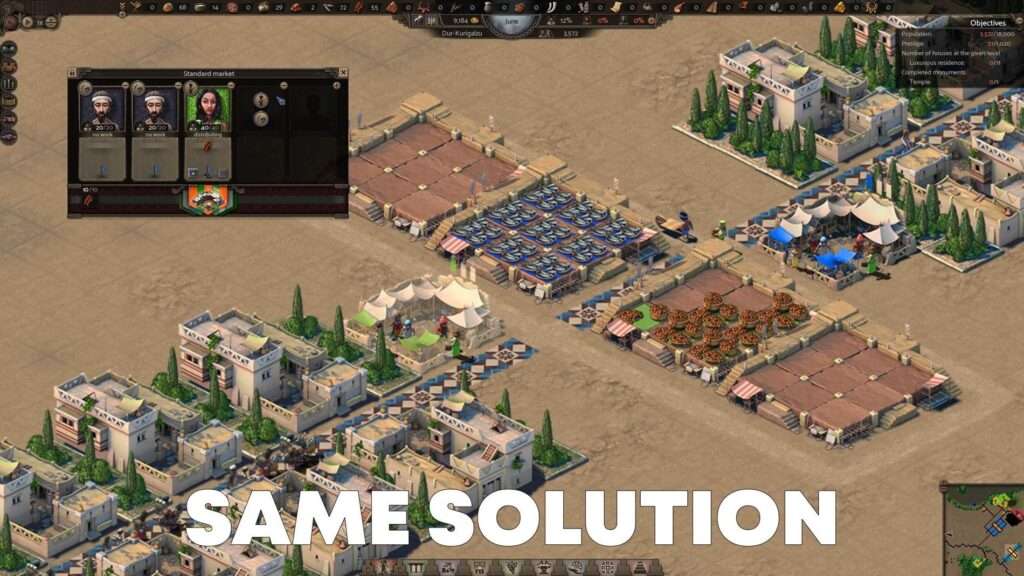
So let’s solve one problem at a time. First let’s start growing barley as it is required for making beer. Just as before, pumps, irrigation channels, a new farm, warehouse, the works. I don’t think I have to go over this again if you have been paying attention to this and the previous part of this guide.
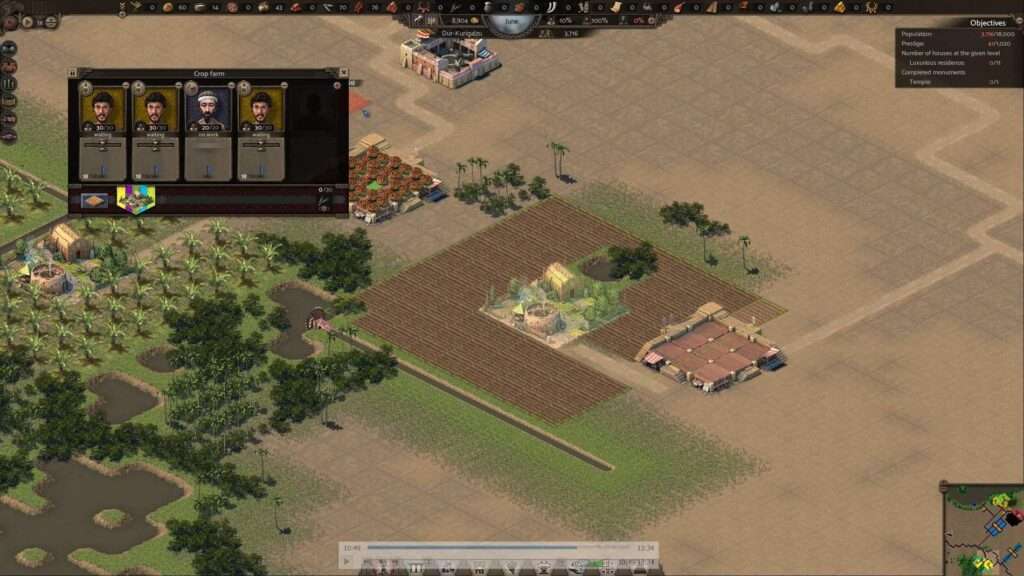
The breweries are a place of work for the townsfolk and they also need a warehouse in range.
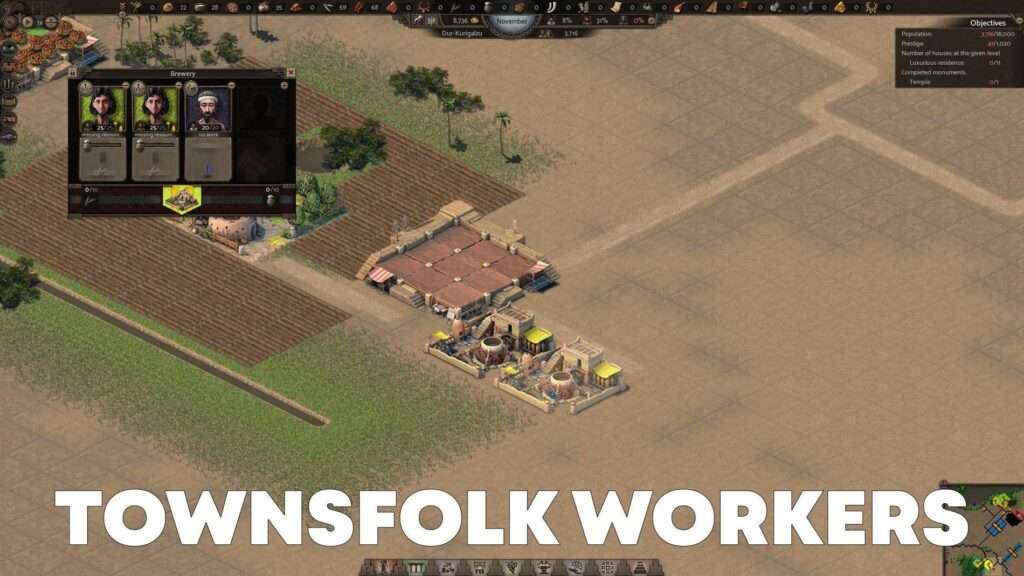
This has quickly drained our townsfolk workforce pool so adding new villas is a must. Same design as before and just make sure to extend the goods distribution paths from the market.
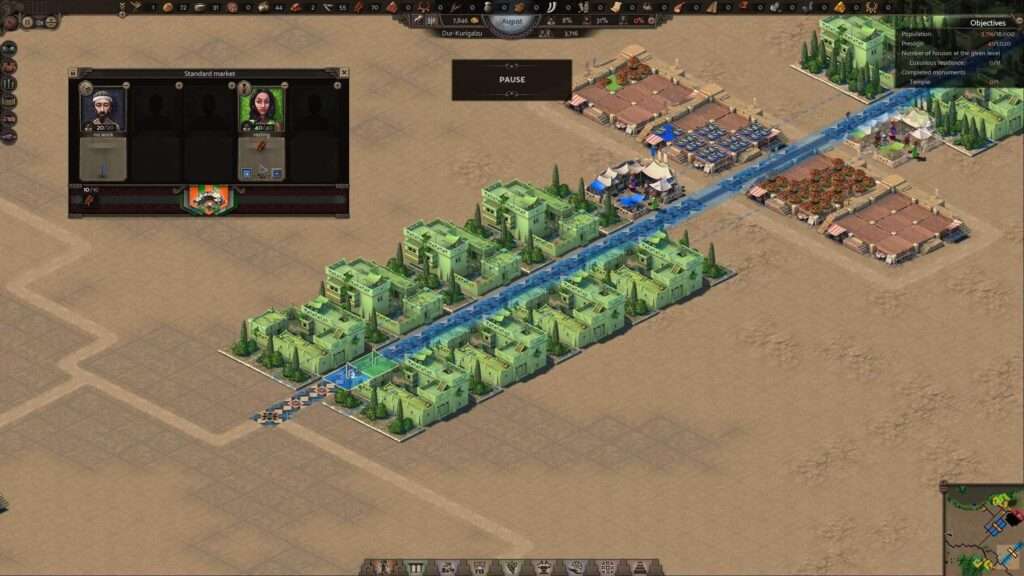
After the first barley harvest brewers will get to work and we will be producing beer in no time. Now if you remember our look at the trade and diplomacy screen from the beginning of the guide, Magan is an importer of beer as well as an exporter of copper which we need.
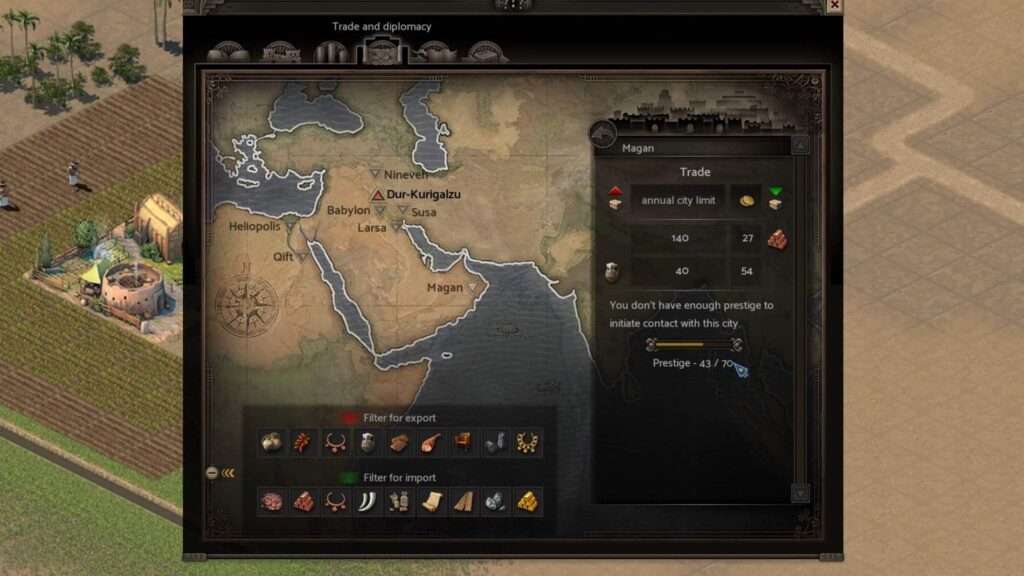
But since the temple is yet not complete, and we are not over 70 prestige, we don’t have that trade route open yet.
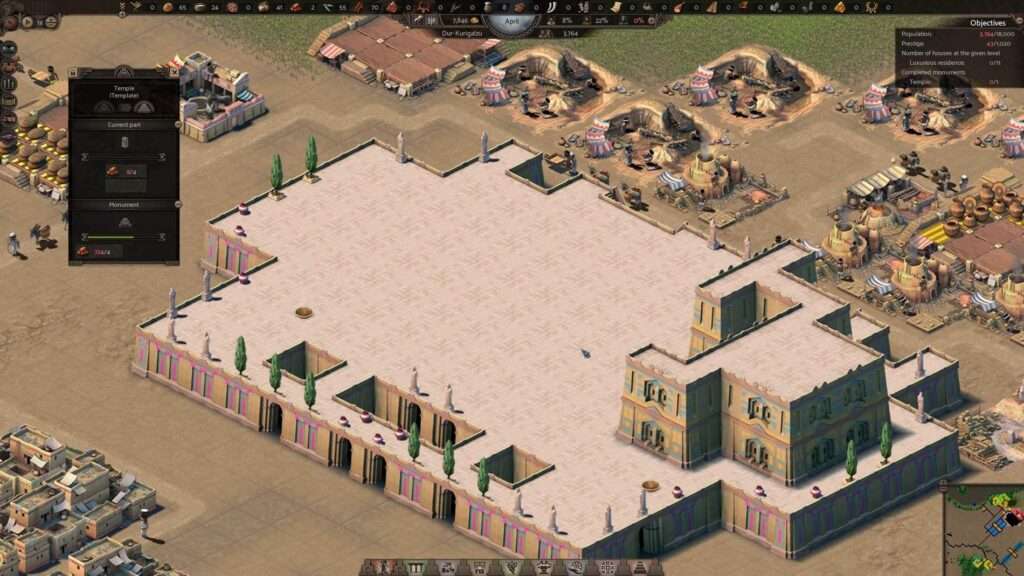
While we wait we can plan out the import/export industry. The port we placed earlier needs a warehouse to be at least one square in its range and whichever good that warehouse has and opening for the port will import or export that good.
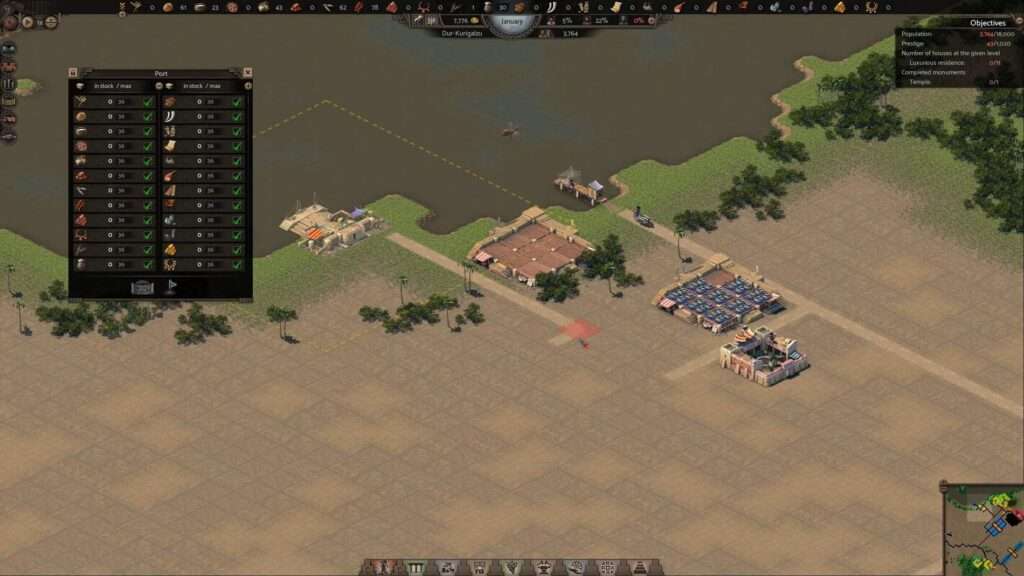
We will set beer to be available and be unloaded at the port while loaded back at the warehouse next to the breweries. A new caravan will transport them from production location to export location.
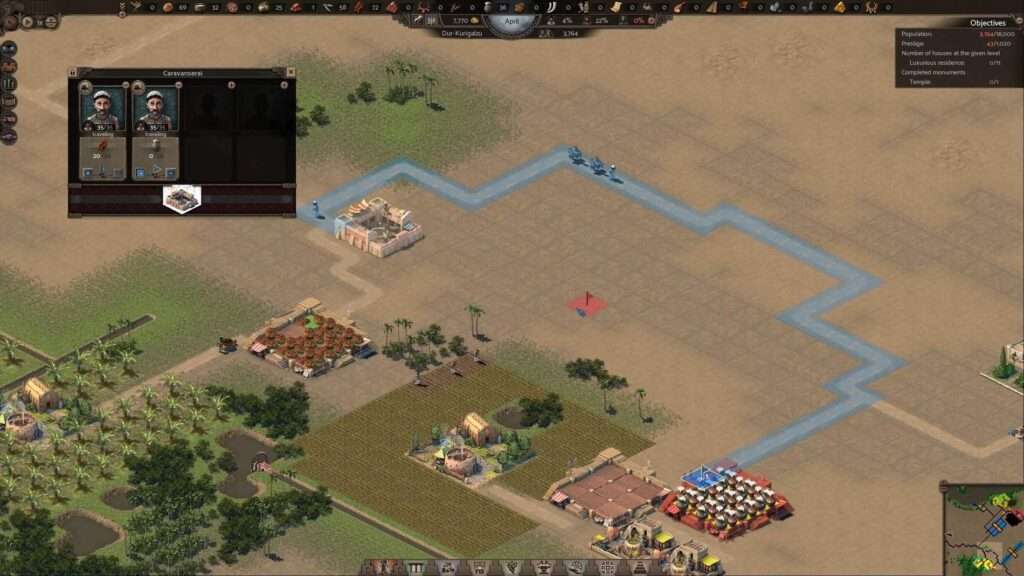
Waiting for the temple to finish we might as well use the overflow of beer to stockpile it next to the poor markets in the peasants area and have it ready for distribution. A new caravan can transport them there.
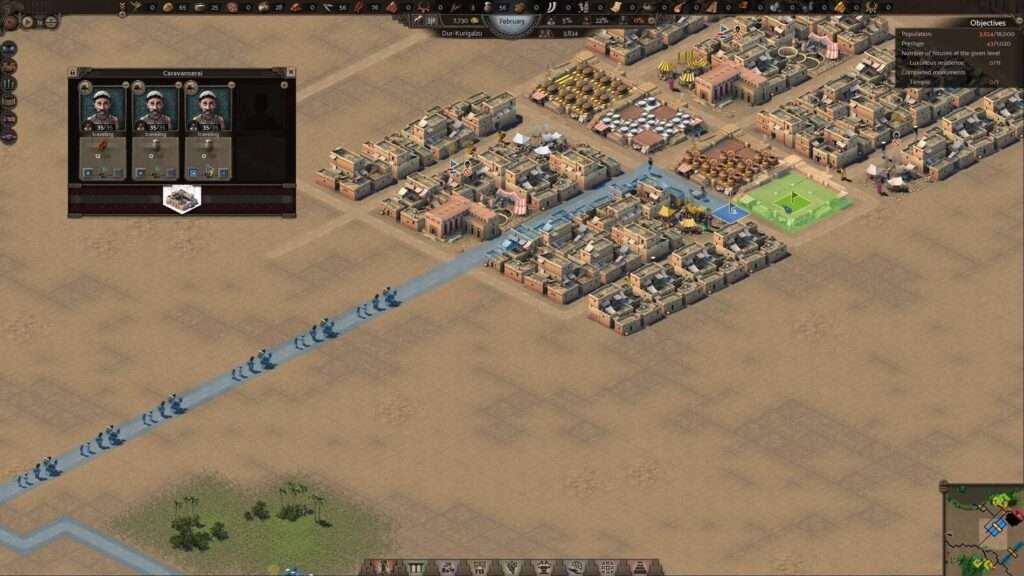
We can squeeze out the last few remaining peasant workers for a new brick maker and clay pit to speed up temple construction. As for the tablets necessary for the administration building they will require a fifth warehouse at the peasant area.
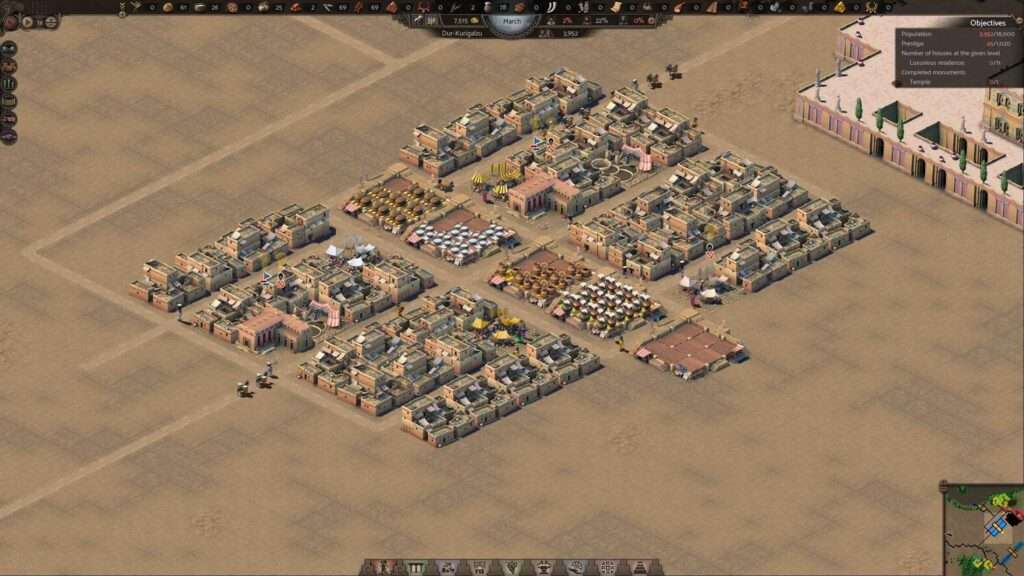
Since beer has been stored up to its maximum and isn’t being used up anywhere currently, we can disable the breweries in favor of making tablets in workshops, as townsfolk work here too.
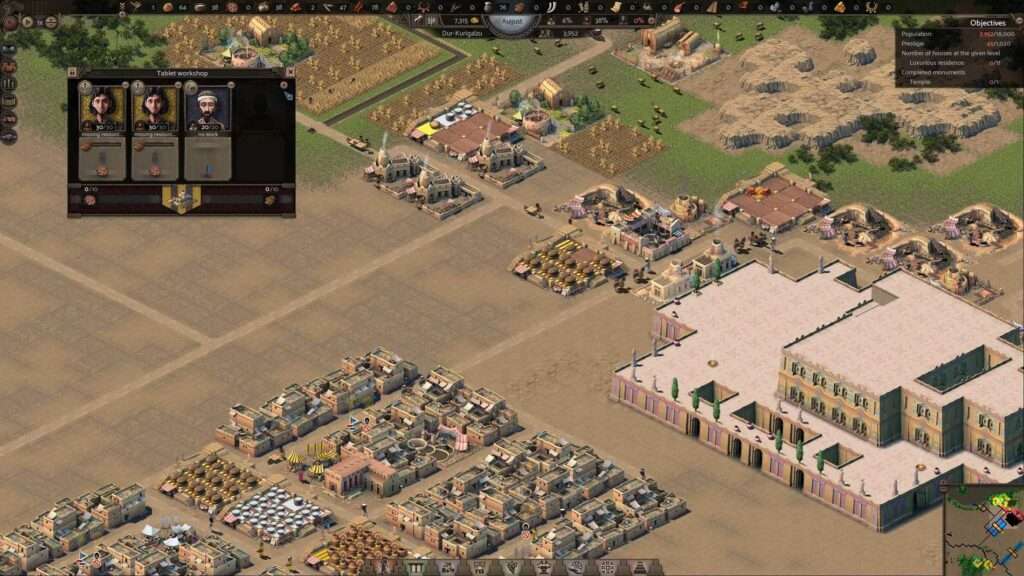
A new warehouse will receive them and a new caravan will transport them to the warehouse closest to the administration buildings. These might be out of range right now, to pick up tablets, but that can be easily fixed in the same way we fixed the poor market situation.
So now we have everything ready and the monument is still under construction we only need to wait for it to finish and unlock these trade routes to other cities with the extra prestige.
This will enable the import of copper, which in turn will let us make copper jewelry in copper workshop, and have one half of the upgrade requirements for villas. The other half is achieved by setting up access to religion as a service. This we can already do since priests are townsfolk.
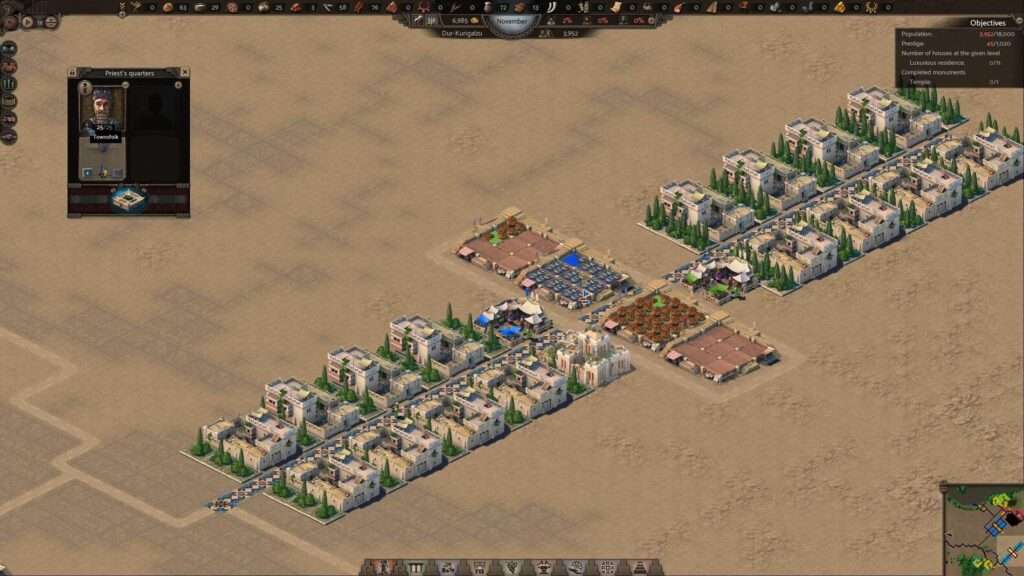
The distribution of religion is done exactly like for goods. After the first pass these villas already have region access.
And that is it for this part of the guide. In the next one we will start to make profits from trade, level up peasants homes to the maximum, villas to the next levels and build residences for the aristocracy.
Make Money & Get Aristocrats / Guide for Residences, Profit & Services
This is a tutorial on How to make Money from trade profits and get Aristocrats to move into Residences in Nebuchadnezzar. I show how to start multiple trade routes with other cities, import raw goods and export finished goods while producing goods locally.
I also explain how to level up peasant’s homes to their fourth (maximum) level with beer and administration service (tablets) and the townsfolk’s villas to their second level (copper jewelry and religious services). Advanced tips for distribution of food and goods from poor, standard and luxurious markets using caravanners and warehouses.


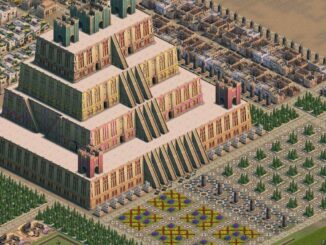
You dont tell how to make priests. Booo!